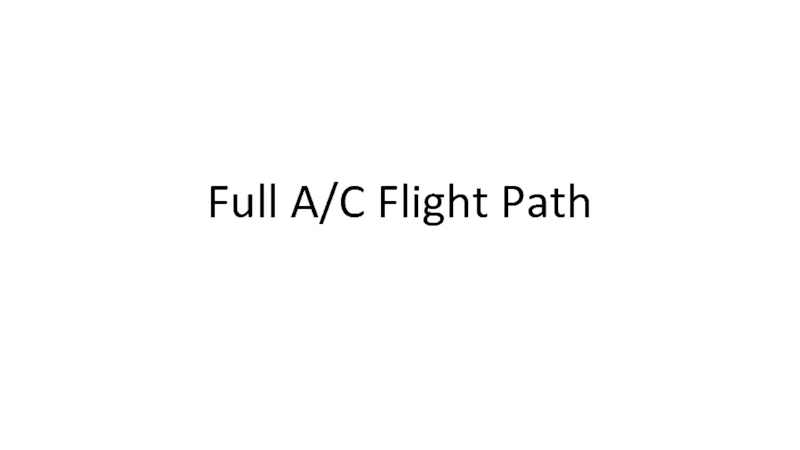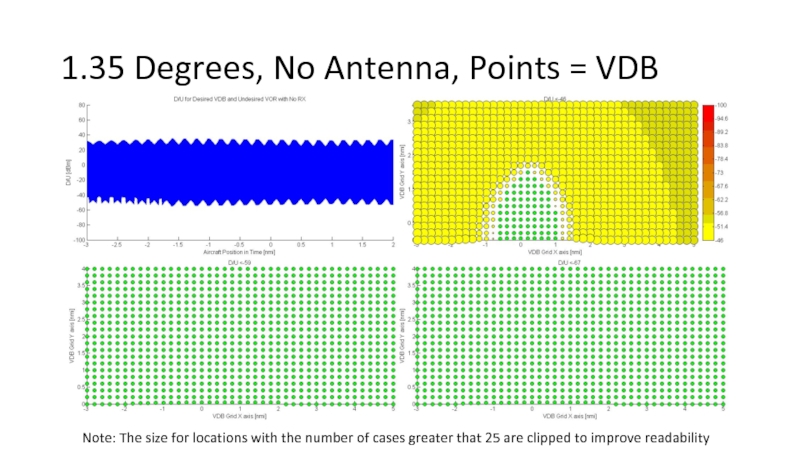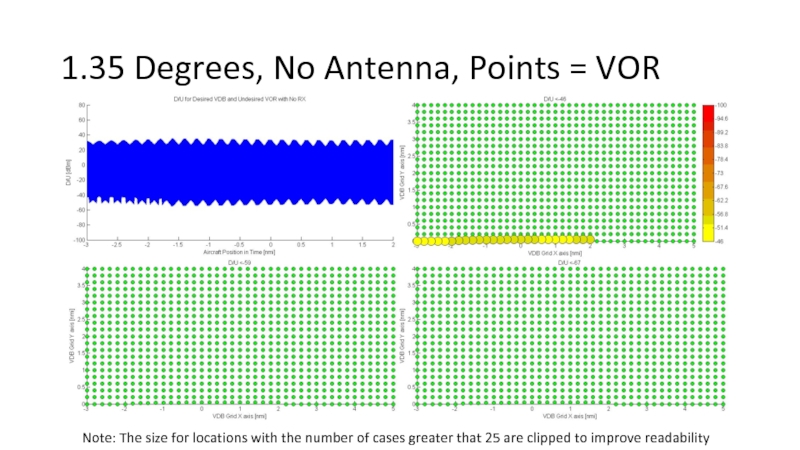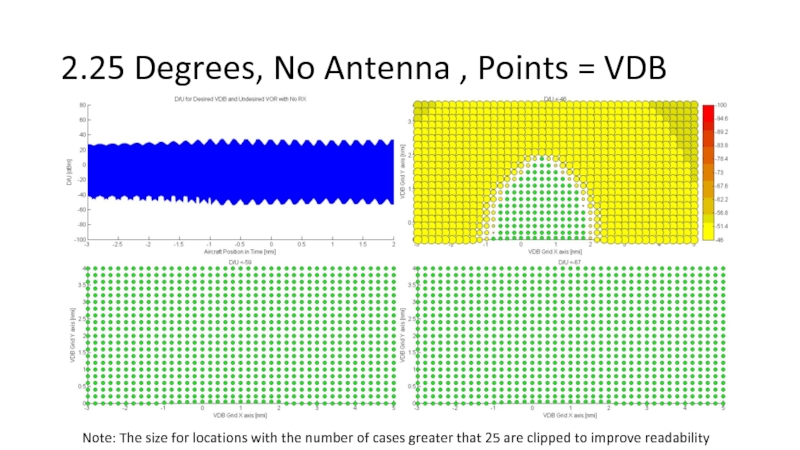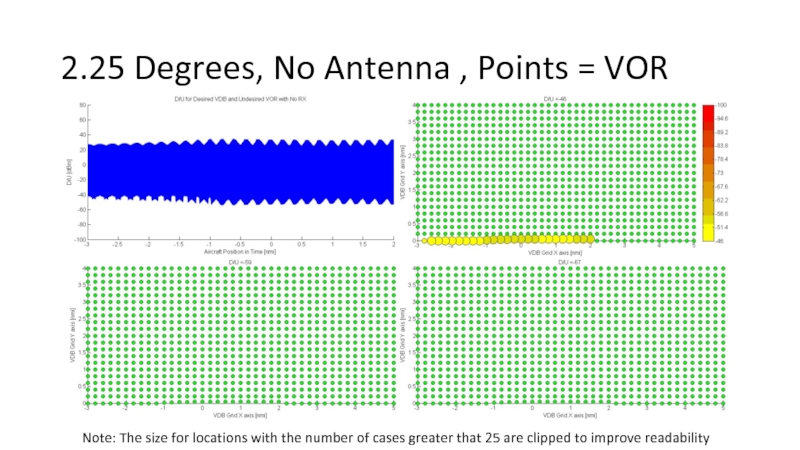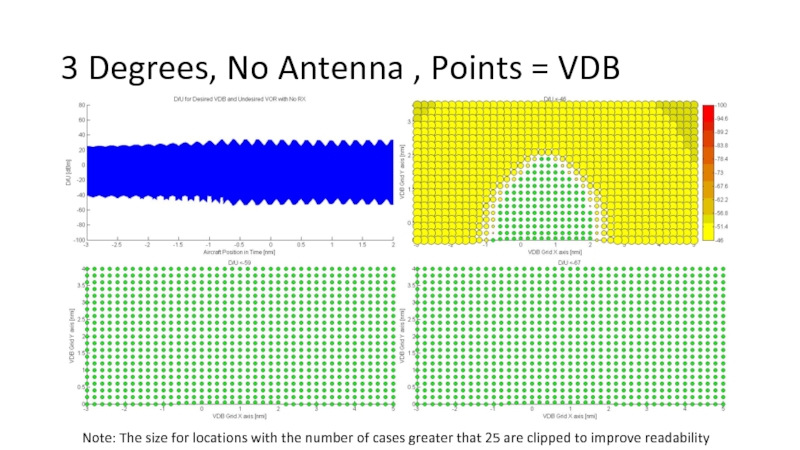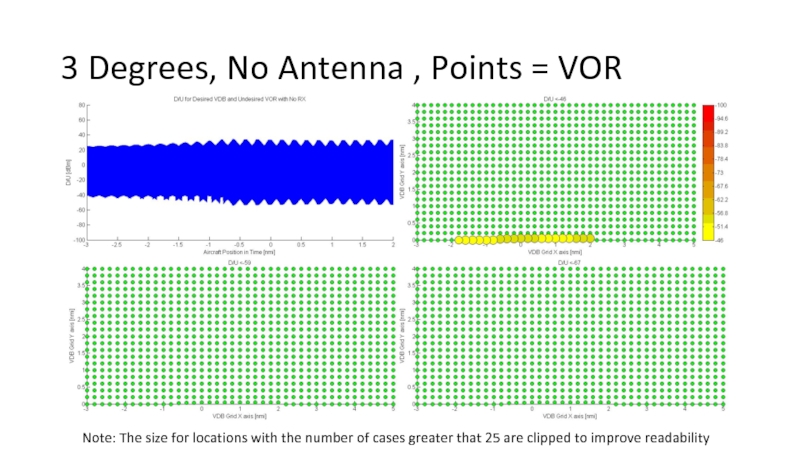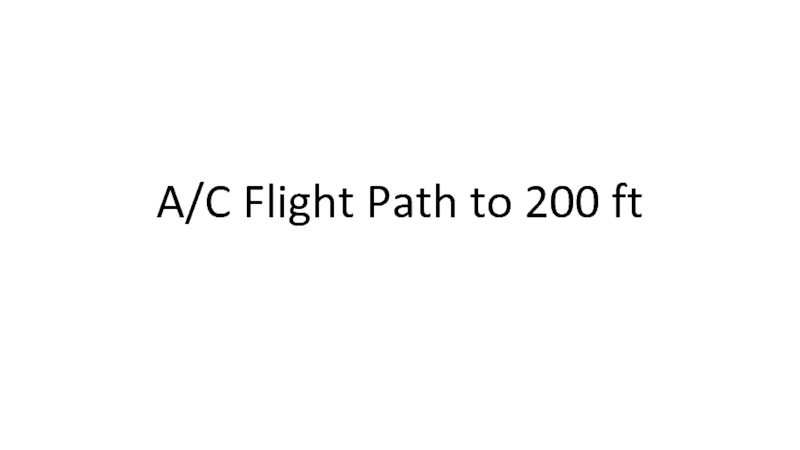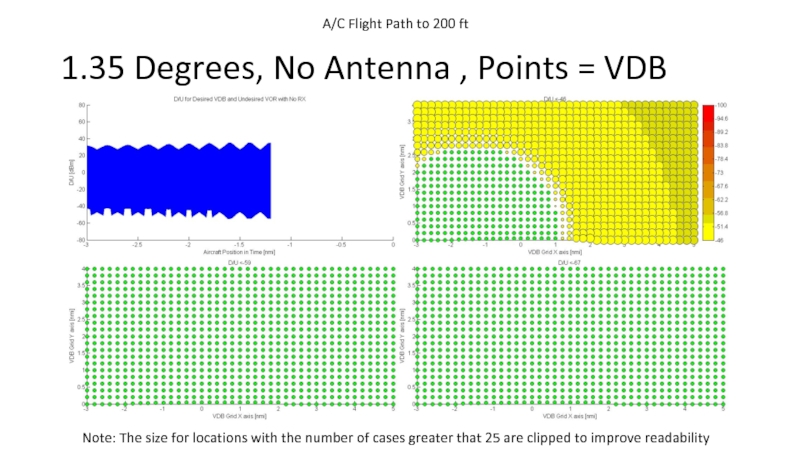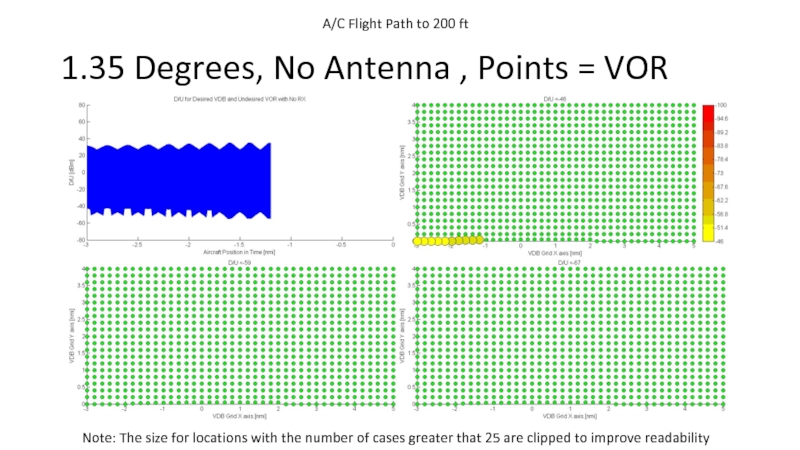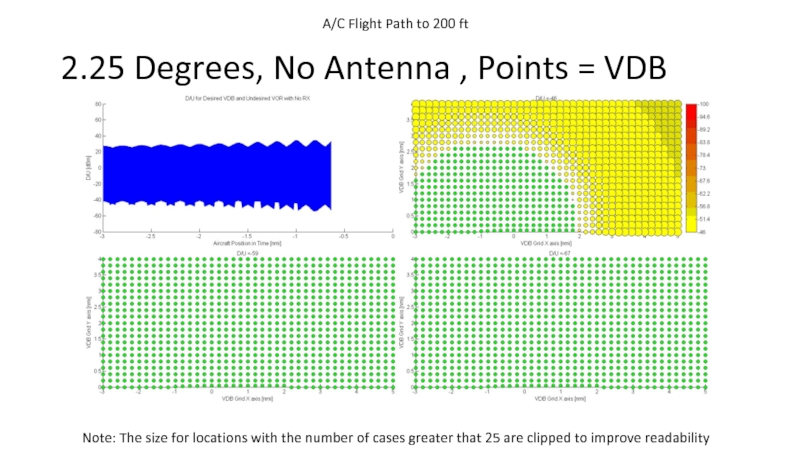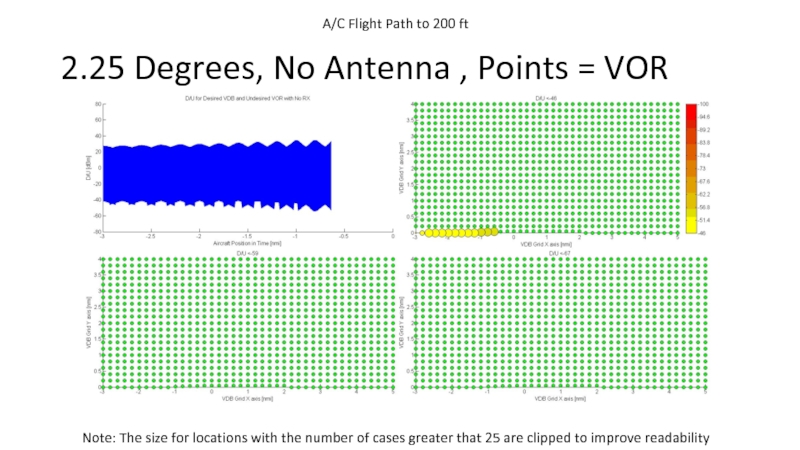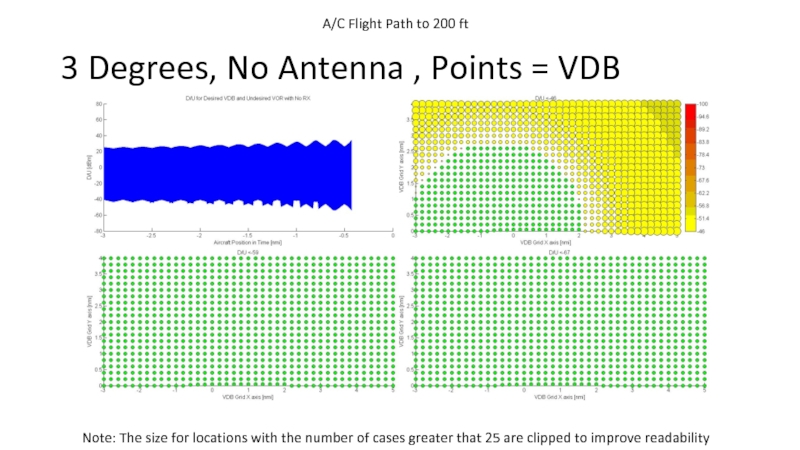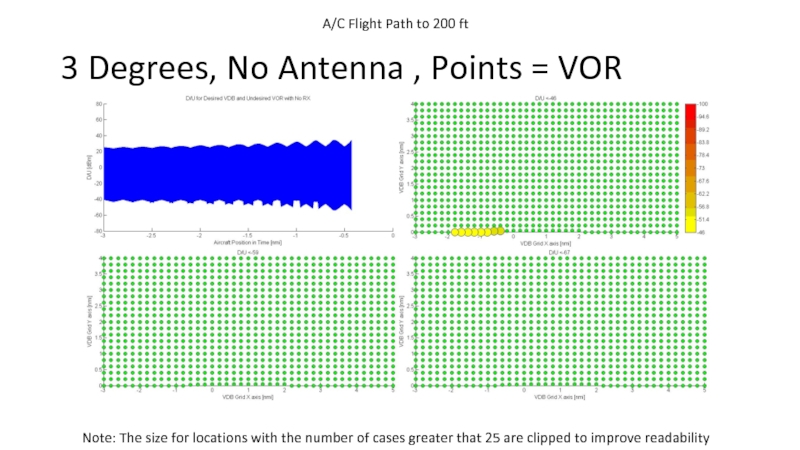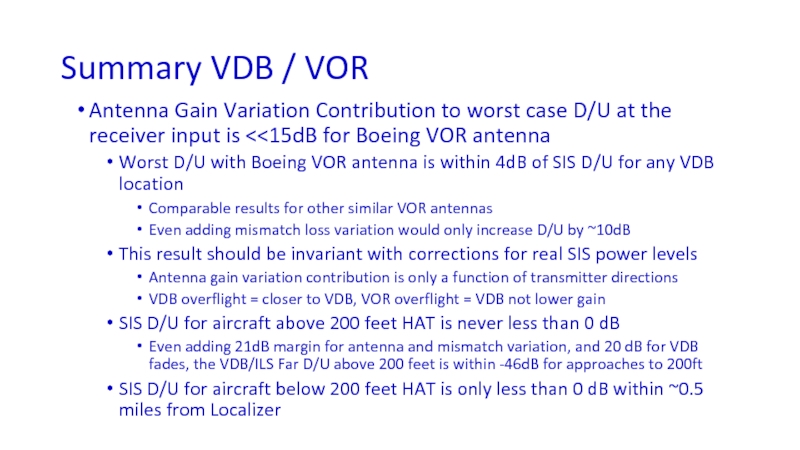- Главная
- Разное
- Дизайн
- Бизнес и предпринимательство
- Аналитика
- Образование
- Развлечения
- Красота и здоровье
- Финансы
- Государство
- Путешествия
- Спорт
- Недвижимость
- Армия
- Графика
- Культурология
- Еда и кулинария
- Лингвистика
- Английский язык
- Астрономия
- Алгебра
- Биология
- География
- Детские презентации
- Информатика
- История
- Литература
- Маркетинг
- Математика
- Медицина
- Менеджмент
- Музыка
- МХК
- Немецкий язык
- ОБЖ
- Обществознание
- Окружающий мир
- Педагогика
- Русский язык
- Технология
- Физика
- Философия
- Химия
- Шаблоны, картинки для презентаций
- Экология
- Экономика
- Юриспруденция
Summary of Approach Simulations to Assess VHF Compatibility for GLS/ILS/VOR презентация
Содержание
- 1. Summary of Approach Simulations to Assess VHF Compatibility for GLS/ILS/VOR
- 2. Overview Summary of Issue Simulation Description Scenarios Results
- 3. Summary of Issue Several navigation aids share
- 4. Summary of Issue, Continued Aircraft installation contributes
- 5. Simulation Overview and Purpose Model nav aid
- 6. Simulation Description Simulate Aircraft on Approach 3
- 7. 1. Simulate Aircraft on Approach
- 8. The green grid denotes the modeled area
- 9. Aircraft positions simulated every 0.002 nmi
- 10. 2. Simulate Airborne Antenna Patterns Simulate no
- 11. 3. Simulate VHF Nav Aids and Transmit Patterns ILS LOC VOR VDB
- 12. 1. Simulate ILS LOC Signal Strength ILS
- 13. ILS Signal Strength Equation FSPL(distance < 822.7611
- 14. Simulated Approach Height vs. LOC Distance Comparing
- 15. Has same general shape, differences could be
- 16. Due to a jump in the
- 17. 2. Simulate VDB Signal Strength VDB simplified
- 18. Compare Simple VDB Model (Red) with Ohio
- 19. Comparing HPOL Results
- 20. Difference OU HPOL Sim and Simple Model
- 21. 3. Simulate VOR Signal Strength VOR simplified
- 22. Compare Simple VOR Model with Bremen Flight
- 23. Bremen test data vs Simulated VOR Signal
- 24. Bremen test data vs Simulated VOR Signal
- 25. Transmit Simplified Models Summary ILS LOC Simplified
- 26. D/U Simulation Results
- 27. D/U Simulation Scenarios VDB Desired / ILS
- 28. VDB Desired / ILS Near Undesired
- 29. Formulas EIRPVDB = 47 dBm [1] EIRPILS
- 30. Explanation on the Scatter plots Each circle
- 31. Full A/C Flight Path
- 32. FPA = 1.35 degrees (lower edge of
- 33. 1.35 Degrees, No Antenna , U = ILS Near
- 34. 1.35 Degrees, Boeing VOR , U = ILS Near
- 35. FPA = 2.25 degrees (full scale low)
- 36. 2.25 Degrees, No Antenna , U = ILS Near
- 37. 2.25 Degrees, Boeing VOR , U = ILS Near
- 38. FPA = 3 degrees (On Glideslope) Plot
- 39. 3 Degrees, No Antenna , U = ILS Near
- 40. 3 Degrees, Boeing VOR , U = ILS Near
- 41. A/C Flight Path to 200 ft
- 42. FPA = 1.35 degrees (Lowest Coverage) Plot
- 43. 1.35 Degrees, No Antenna, U = ILS Near
- 44. 1.35 Degrees, Boeing VOR, U = ILS Near
- 45. FPA = 2.25 degrees (Full Scale Low)
- 46. 2.25 Degrees, No Antenna, U = ILS Near
- 47. 2.25 Degrees, Boeing VOR, U = ILS Near
- 48. FPA = 3 degrees (On Glideslope) Plot
- 49. 3 Degrees, No Antenna, U = ILS Near
- 50. 3 Degrees, Boeing VOR, U = ILS Near
- 51. Summary VDB / ILS Near D/U Antenna
- 52. VDB Desired / ILS Far Undesired VDB
- 53. Formulas EIRPVDB = 47 dBm [1] EIRPILS
- 54. Full A/C Flight Path
- 55. 1.35 Degrees, No Antenna, U = ILS Far
- 56. 2.25 Degrees, No Antenna, U = ILS Far
- 57. 3 Degrees, No Antenna, U = ILS Far
- 58. A/C Flight Path to 200 ft
- 59. 1.35 Degrees, No Antenna, U = ILS Far
- 60. 2.25 Degrees, No Antenna, U = ILS Far
- 61. 3 Degrees, No Antenna, U = ILS Far
- 62. Summary VDB / ILS Far D/U Antenna
- 63. VDB Desired / VOR Undesired VDB Location
- 64. Assumptions VOR antenna is 10 meters above
- 65. Formulas EIRPVDB = 47 dBm [1] EIRPVOR
- 66. Full A/C Flight Path
- 67. 1.35 Degrees, No Antenna, Points = VDB
- 68. 1.35 Degrees, No Antenna, Points = VOR
- 69. 2.25 Degrees, No Antenna , Points =
- 70. 2.25 Degrees, No Antenna , Points =
- 71. 3 Degrees, No Antenna , Points =
- 72. 3 Degrees, No Antenna , Points =
- 73. A/C Flight Path to 200 ft
- 74. 1.35 Degrees, No Antenna , Points =
- 75. 1.35 Degrees, No Antenna , Points =
- 76. 2.25 Degrees, No Antenna , Points =
- 77. 2.25 Degrees, No Antenna , Points =
- 78. 3 Degrees, No Antenna , Points =
- 79. 3 Degrees, No Antenna , Points =
- 80. Summary VDB / VOR Antenna Gain Variation
Слайд 1Summary of Approach Simulations to Assess VHF Compatibility for GLS/ILS/VOR
Matt Harris,
10/11/2016
Слайд 3Summary of Issue
Several navigation aids share the same VHF spectrum (108
VDB – VHF Data Broadcast for GLS
VOR – VHF Omnidirectional Range
ILS – Instrument Landing System Localizer
VHF Comm/Data – Voice Communication and VHF Data Link
Airborne navigation and landing equipment must be able to operate with minimum desired signal
with undesired signals much stronger at adjacent channels than the desired signal
Current ILS, VOR, VDB specification requires compatibility with -46 dB D/U at 75 kHz adjacent and beyond
Airborne antenna gain variation is allowed to be 7 to 15+ dB, specified in the horizontal direction
Слайд 4Summary of Issue, Continued
Aircraft installation contributes to D/U limits
Antenna gain variation
Antenna gain variation is limited to ~15dB in the horizontal
Installed antenna gain at low elevations can be overcome by reduced transmission loss
Mismatch loss variation due to difference in frequency of desired / undesired
Mismatch loss can vary by 6dB for the worst combination of distant frequencies
Mismatch loss negligible at close frequency separation
Signal-in-space D/U must have margin for aircraft installation
Receiver D/U limit plus installation contribution
Results in more stringent signal-in-space D/U limit (+10dB?, +15 dB?, +20 dB?)
Can required D/U performance be constrained with VDB siting constraints?
Слайд 5Simulation Overview and Purpose
Model nav aid transmitters, including transmission loss (ILS,
Model aircraft on approach, including aircraft antenna patterns (VOR antenna)
For each scenario of desired / undesired, determine D/U power levels vs. VDB location (rough precision)
Can a receiver specification be feasibly determined?
Does the full installation gain variation margin apply for all cases?
Can any credit for relative location of transmitters be taken?
Слайд 6Simulation Description
Simulate Aircraft on Approach
3 degrees, 2.25 degrees (full scale low),
2 mile runway length
Simulate Airborne Receive Antenna Patterns
No airborne pattern (signal-in-space power level)
Boeing VOR antenna pattern from scale model measurements
Simulate VHF Nav Aids and Transmit Antenna Patterns
ILS near, ILS far, VDB grid, VOR grid
ILS antenna pattern and power levels calibrated with other data
VDB simplistic model calibrated against other higher fidelity models
VOR simplistic model (compared with flight data)
VOR/VDB > 80m from aircraft path
Слайд 7
1. Simulate Aircraft on Approach (not to scale)
ILS Near
ILS Far
VDB /
2 NM
D=305m,
H=3m
D=305m,
H=3m
80m VDB/VOR exclusion
Antenna on 3-degree Approach, TCH=60ft, H = 10ft above runway during rollout
2.25-degree Path (full scale low on 3-degree)
1.35-degree Path (minimum service coverage)
Слайд 8The green grid denotes the modeled area (only covers one side
Runway Length: 2 nmi
Grid points < 80m from A/C flight path were moved in the Y direction until 80m separation achieved
A/C initial ground distance = 3 nmi
A/C height at threshold: 60 ft
The A/C antenna height when on runway is 10 ft
VOR and VDB Antennas
H = 10 m
Distance between Locations = 0.2 nmi
Слайд 9
Aircraft positions simulated every 0.002 nmi
Aircraft positions simulated every 0.01 nmi
Additional
Слайд 102. Simulate Airborne Antenna Patterns
Simulate no Airborne Antenna Pattern
Provides Signal-In-Space Desired
Accounts for transmission loss for actual transmitter locations
Boeing VOR antenna pattern from scale model measurements
Proprietary installed patterns will not be published or shared
Measurements smoothed from 0.1 degree resolution to reduce spikes
Spikes believed to be an artifact of the scale model measurement setup
average of nearest values +/- 0.1 degrees
Max and min values in a [3-degree] az/el window were determined
Selected higher gain pattern for undesired, lower gain for desired signal
Difference in D/U with and without antenna pattern
Слайд 121. Simulate ILS LOC Signal Strength
ILS Localizer Antenna Pattern
Source: Stefan Müller
ILS Path Loss 1/r Behavior within ½ Far Field (One-Half Far Field Boundary ~ 2700 feet)
Source: Orville Nyhous letter to RTCA SC-159 WG4 VDB ad-hoc team, “Computation of Received Signal Levels in the Near Field Region of a Localizer (LOC)”, May 2016 – Picture from Van Valkenburg, M. E., Reference Data for Engineers: Radio, Electronics, Computer, and Communications, Eighth Edition, SAMS, Prentice Hall, 1993, Page 32-7.
60dBm
peak
Слайд 13ILS Signal Strength Equation
FSPL(distance < 822.7611 m)
= 10*log10(distance) + 20*log10(108
FSPL(distance >822.7611 m)
= 20*log10(distance) + 20*log10(108 MHz) – 147.5
SignaldBW = PTx + Gain from Antenna Pattern (Relative to Main Beam)
+ Main Beam Gain + FSPL - 30
SignaldBW = 47 dBm + Gain from Antenna Pattern + 13 dB + FSPL - 30
Слайд 14Simulated Approach Height vs. LOC Distance
Comparing simulated antenna heights with heights
Слайд 15Has same general shape, differences could be due to differences in
Слайд 16
Due to a jump in the traced Transmitter gain antenna
Recreating Navcom
Peak near ILS LOC antenna (@100’ height above LOC):
Navcom = -25dBm
Simplified Model = -22dBm
Слайд 172. Simulate VDB Signal Strength
VDB simplified model
Simulated as omnidirectional with transmit
No transmission losses assumed, path loss simulated as 1/r2
Matches Ohio University model fairly well (ignoring fades)
Слайд 18Compare Simple VDB Model (Red) with Ohio University EM Model and
From: Skidmore, Wilson, Dickinson, Nyhus, “The LAAS VHF Data Broadcast Modeling, Siting, Flight Inspection, and Flight Test Results”, ION GPS 2001, Salt Lake City, Utah
Слайд 20Difference OU HPOL Sim and Simple Model
Matches roughly well within +/-5dB,
These simulation results will only work as a guideline for validation - actual VDB levels must be used in practice
Слайд 213. Simulate VOR Signal Strength
VOR simplified model
Simulated as +6dB gain below
No transmission losses assumed, path loss simulated as 1/r2
Transmit power set to 50 dBm (100W) for D/U calculations
Compared with Bremen flight inspection, setting power to 200W, SIS power levels using this simple model result in SIS power levels ~15dB too high
Слайд 22Compare Simple VOR Model with Bremen Flight Inspection Measurements
The EIRP is
Ground Antenna Gain is simulated as:
-4 dB in the Cone of Silence (elevation > 60 degrees)
6 dB elsewhere
FSPL = 20*log10(distancemeter) + 20*log10(117.45 MHz) – 147.55
Signal Strength (dBW/m2) = EIRP (dBm) + GainGroundAntenna – FSPL – 30
Слайд 23Bremen test data vs Simulated VOR Signal
(No Simulated Aircraft Antenna)
27 Approach,
27 Approach Go Around – VOR overflight at 400’
Слайд 24Bremen test data vs Simulated VOR Signal
(No Simulated Aircraft Antenna)
09 Approach
27 Approach – No VOR overflight
Слайд 25Transmit Simplified Models Summary
ILS LOC
Simplified model based on NavCom gain vs.
Matches well with other NavCom results, but may be a few dB too high for close overflights
VDB
Simplified model is isotropic
Does not account for up to 15dB fades in real life
Actual SIS power levels will be accounted for during inspection
VOR
Simplified model has 10dB reduced gain above 60 degrees
Produces power levels that are about 15dB higher than flight inspection results
15dB increase in undesired VOR coincidentally covers lack of VDB fade modeling
Слайд 27D/U Simulation Scenarios
VDB Desired / ILS Near Undesired
VDB Desired / ILS
VDB Desired / VOR Undesired (and VOR / VDB)
Слайд 28VDB Desired / ILS Near Undesired
VDB Location Grid and ILS
Scatter plots for VDB Location
Слайд 29Formulas
EIRPVDB = 47 dBm [1]
EIRPILS in the main beam = 60
Gtransmitter,VDB = 0 dB (Isotropic Antenna)
FSPLILS,D > 822 m = 20*log10(D) + 20*log10(108) – 147.55
Frequency for the undesired chosen to yield the smaller FSPL
FSPLILS,D < 822 m = 10*log10(D) + 20*log10(108) – 147.55 + 29.15
FSPLVDB = 20*log10(D) + 20*log10(117.95) – 147.55
Frequency for the desired chosen to yield the bigger FSPL
PVDB = EIRPVDB + Gtransmitter,VDB + GReceiver,VDB – FSPLVDB
PILS = EIRPILS + Gtransmitter,ILS + GReceiver,ILS – FSPLILS
D/U = PVDB – PILS
[1] Source: Stefan Müller and Felix Butsch and Helmut Günzel, “Investigation of GBAS frequency protection requirements at third adjacent channel and beyond,” DFS Deutche Flugsicherung GmbH, Version 0.10, 13.11.2015
Слайд 30Explanation on the Scatter plots
Each circle corresponds with a GBAS antenna
If the dot is green then no VDB antenna location causes the D/U for that GBAS location to go below the threshold.
If VDB antenna locations cause the D/U to go below the threshold then the color corresponds with the worst case.
If the color is not green, the size of the dot corresponds with how many times a VDB antenna on the grid was less than the threshold.
The color bar on the right only appears if there is a GBAS antenna location that is not green.
Слайд 32FPA = 1.35 degrees (lower edge of coverage)
Plot 1 : Plots
Plot 2 : Scatterplot of Threshold = -46
Plot 3 : Scatterplot of Threshold = -59
Plot 4 : Scatterplot of Threshold = -67
Threshold = the limit of the D/U required to be tolerable at the receiver input
Слайд 35FPA = 2.25 degrees (full scale low)
Plot 1 : Plots of
Plot 2 : Scatterplot of Threshold = -46
Plot 3 : Scatterplot of Threshold = -59
Plot 4 : Scatterplot of Threshold = -67
Threshold = the limit of the D/U required to be tolerable at the receiver input
Слайд 38FPA = 3 degrees (On Glideslope)
Plot 1 : Plots of the
Plot 2 : Scatterplot of Threshold = -46
Plot 3 : Scatterplot of Threshold = -59
Plot 4 : Scatterplot of Threshold = -67
Threshold = the limit of the D/U required to be tolerable at the receiver input
Слайд 42FPA = 1.35 degrees (Lowest Coverage)
Plot 1 : Plots of the
Plot 2 : Scatterplot of Threshold = -46
Plot 3 : Scatterplot of Threshold = -59
Plot 4 : Scatterplot of Threshold = -67
Threshold = the limit of the D/U required to be tolerable at the receiver input
Слайд 45FPA = 2.25 degrees (Full Scale Low)
Plot 1 : Plots of
Plot 2 : Scatterplot of Threshold = -46
Plot 3 : Scatterplot of Threshold = -59
Plot 4 : Scatterplot of Threshold = -67
Threshold = the limit of the D/U required to be tolerable at the receiver input
Слайд 48FPA = 3 degrees (On Glideslope)
Plot 1 : Plots of the
Plot 2 : Scatterplot of Threshold = -46
Plot 3 : Scatterplot of Threshold = -59
Plot 4 : Scatterplot of Threshold = -67
Threshold = the limit of the D/U required to be tolerable at the receiver input
Слайд 51Summary VDB / ILS Near D/U
Antenna Gain Variation Contribution to worst
Worst D/U with Boeing VOR antenna is within 3dB of SIS D/U for any VDB location
Comparable results for other similar VOR antennas
Even adding mismatch loss variation would only increase D/U by ~10dB
This result should be invariant with corrections for real SIS power levels
Antenna gain variation contribution is only a function of transmitter directions
VDB overflight = closer to VDB, ILS overflight = VDB not lower antenna gain
SIS D/U for aircraft above 200 feet HAT is never less than -15 dB
Even adding 10dB margin for VOR antenna and mismatch variation, and 20 dB for model simplicity, the VDB/ILS Near D/U above 200 feet is within -46dB
Слайд 52VDB Desired / ILS Far Undesired
VDB Location Grid and ILS Far
Scatter plots for VDB Location
Слайд 53Formulas
EIRPVDB = 47 dBm [1]
EIRPILS in the main beam = 60
GTransmitter,VDB = 0 dB (Isotropic Antenna)
FSPLILS,D > 822 m = 20*log10(D) + 20*log10(108 MHz) – 147.55
FSPLILS,D < 822 m = 10*log10(D) + 20*log10(108 MHz) – 147.55 + 29.15
FSPLVDB = 20*log10(D) + 20*log10(117.95 MHz) – 147.55
PVDB = EIRPVDB + GTransmitter,VDB + GReceiver,VDB – FSPLVDB
PILS = EIRPILS + GTransmitter,ILS + GReceiver,ILS – FSPLILS
D/U = PVDB – PILS
[1] Source: Stefan Müller and Felix Butsch and Helmut Günzel, “Investigation of GBAS frequency protection requirements at third adjacent channel and beyond,” DFS Deutche Flugsicherung GmbH, Version 0.10, 13.11.2015
Слайд 62Summary VDB / ILS Far D/U
Antenna Gain Variation Contribution to worst
Worst D/U with Boeing VOR antenna is within 3dB of SIS D/U for any VDB location
Comparable results for other similar VOR antennas
Even adding mismatch loss variation would only increase D/U by ~10dB
Takeoff heading away from ILS Far using LOC antenna not studied
Takeoff heading away from ILS Far using VOR antenna should be similar
This result should be invariant with corrections for real SIS power levels
Antenna gain variation contribution is only a function of transmitter directions
VDB overflight = closer to VDB
SIS D/U for aircraft above 200 feet HAT is never less than 0 dB
Even adding 21dB margin for antenna and mismatch variation, and 20 dB for VDB fades, the VDB/ILS Far D/U above 200 feet is within -46dB for approaches to 200ft
SIS D/U for aircraft below 200 feet HAT is only less than 0 dB within ~0.5 miles from Localizer
Слайд 63VDB Desired / VOR Undesired
VDB Location Grid and VOR Location Grid
Scatter
Слайд 64Assumptions
VOR antenna is 10 meters above the ground
VDB antenna is 10
The airplane height above threshold = 60 ft
The airborne antenna is 10 ft above the ground once the aircraft is rolling on the runway
The runway is 2 nmi long
The grid extends 3 nmi out from both ends of the runway and 4 nmi out from one side
The aircraft’s flight path begins 3 nmi ground distance from the runway end
The VDB positions are every 0.2 nmi
The aircraft steps 0.01 nmi
The VDB positions less than 80 m from the aircraft flight path were moved in the Y direction so that there is 80 m separation
The Undesired VOR had a frequency of 108.025 MHz.
The Desired VDB had a frequency of 117.95 MHz.
Слайд 65Formulas
EIRPVDB = 47 dBm [1]
EIRPVOR = 50 dBm [1]
GTransmitter,VDB = 0
GTransmitter,VOR = -4 dB in the “cone of silence” [1]
6 dB elsewhere
FSPLVOR = 20*log10(D) + 20*log10(108) – 147.55
FSPLVDB = 20*log10(D) + 20*log10(117.95) – 147.55
PVDB = EIRPVDB + GTransmitter,VDB + GReceiver,VDB – FSPLVDB
PVOR = EIRPVOR + GTransmitter,VOR + GReceiver,VOR – FSPLVOR
D/Points = PVDB – PVOR
[1] Source: Stefan Müller and Felix Butsch and Helmut Günzel, “Investigation of GBAS frequency protection requirements at third adjacent channel and beyond,” DFS Deutche Flugsicherung GmbH, Version 0.10, 13.11.2015
Слайд 671.35 Degrees, No Antenna, Points = VDB
Note: The size for locations
Слайд 681.35 Degrees, No Antenna, Points = VOR
Note: The size for locations
Слайд 692.25 Degrees, No Antenna , Points = VDB
Note: The size for
Слайд 702.25 Degrees, No Antenna , Points = VOR
Note: The size
Слайд 713 Degrees, No Antenna , Points = VDB
Note: The size for
Слайд 723 Degrees, No Antenna , Points = VOR
Note: The size for
Слайд 741.35 Degrees, No Antenna , Points = VDB
Note: The size for
A/C Flight Path to 200 ft
Слайд 751.35 Degrees, No Antenna , Points = VOR
Note: The size for
A/C Flight Path to 200 ft
Слайд 762.25 Degrees, No Antenna , Points = VDB
Note: The size for
A/C Flight Path to 200 ft
Слайд 772.25 Degrees, No Antenna , Points = VOR
Note: The size for
A/C Flight Path to 200 ft
Слайд 783 Degrees, No Antenna , Points = VDB
Note: The size for
A/C Flight Path to 200 ft
Слайд 793 Degrees, No Antenna , Points = VOR
Note: The size for
A/C Flight Path to 200 ft
Слайд 80Summary VDB / VOR
Antenna Gain Variation Contribution to worst case D/U
Worst D/U with Boeing VOR antenna is within 4dB of SIS D/U for any VDB location
Comparable results for other similar VOR antennas
Even adding mismatch loss variation would only increase D/U by ~10dB
This result should be invariant with corrections for real SIS power levels
Antenna gain variation contribution is only a function of transmitter directions
VDB overflight = closer to VDB, VOR overflight = VDB not lower gain
SIS D/U for aircraft above 200 feet HAT is never less than 0 dB
Even adding 21dB margin for antenna and mismatch variation, and 20 dB for VDB fades, the VDB/ILS Far D/U above 200 feet is within -46dB for approaches to 200ft
SIS D/U for aircraft below 200 feet HAT is only less than 0 dB within ~0.5 miles from Localizer
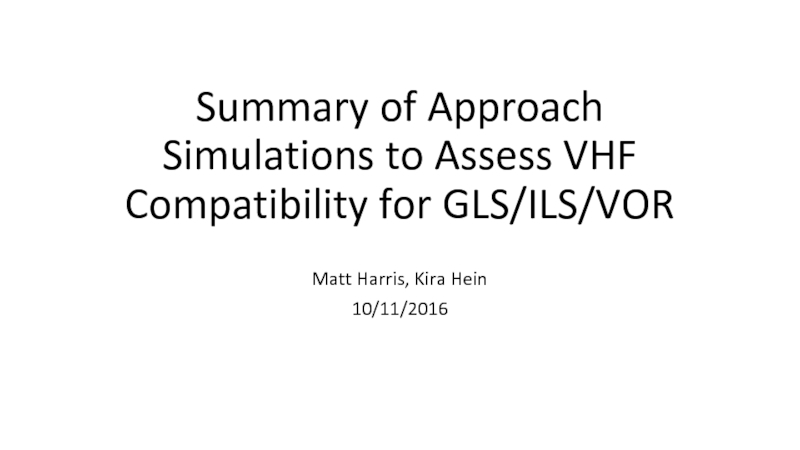
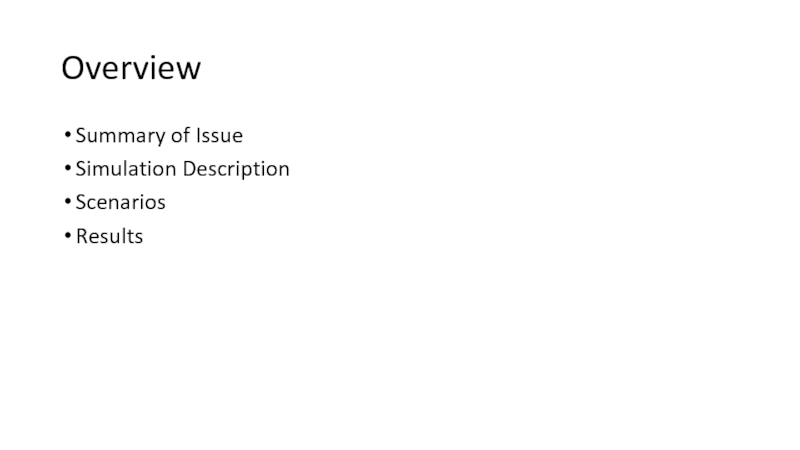
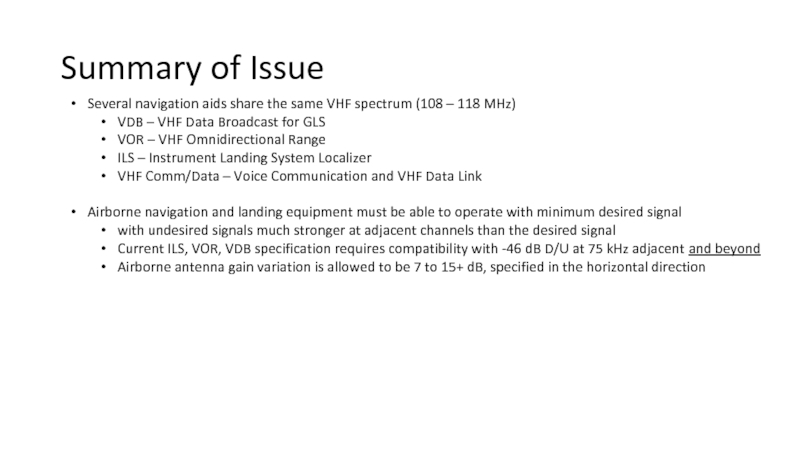
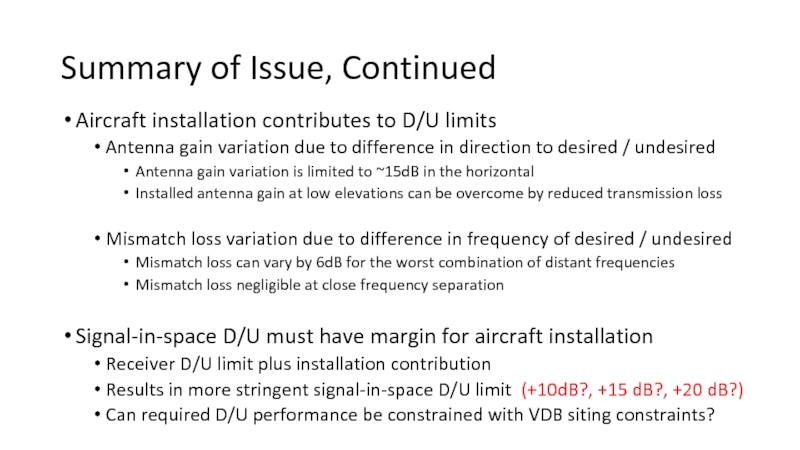
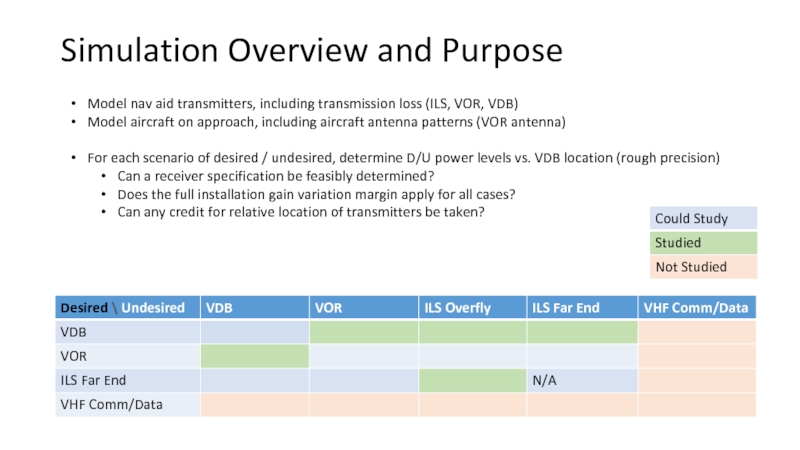
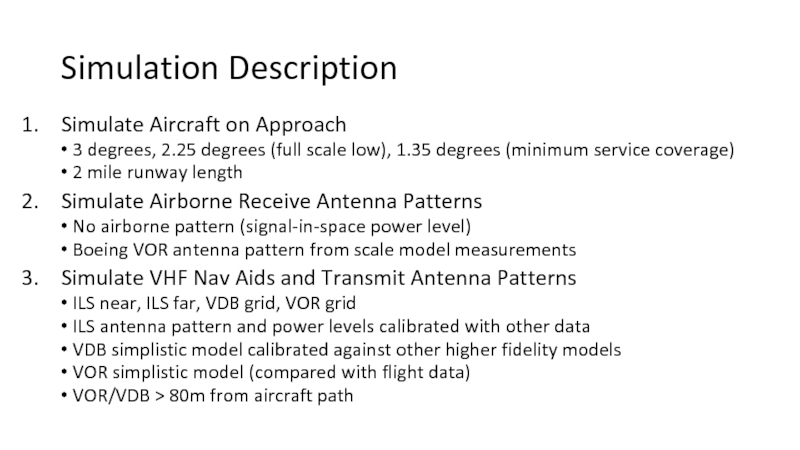
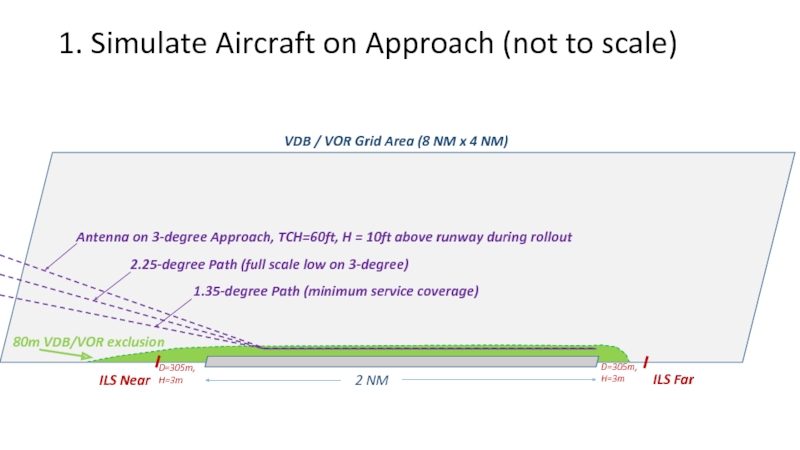
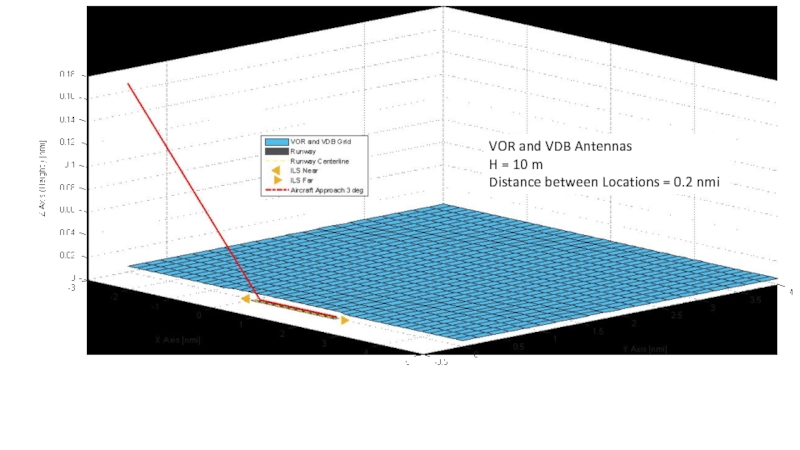
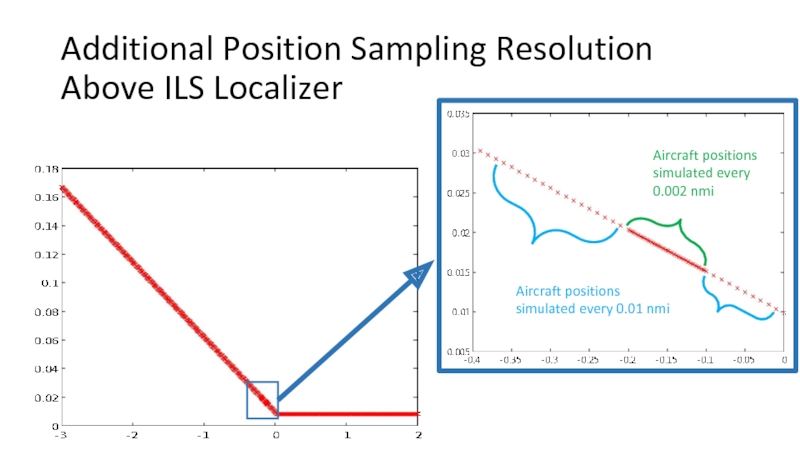
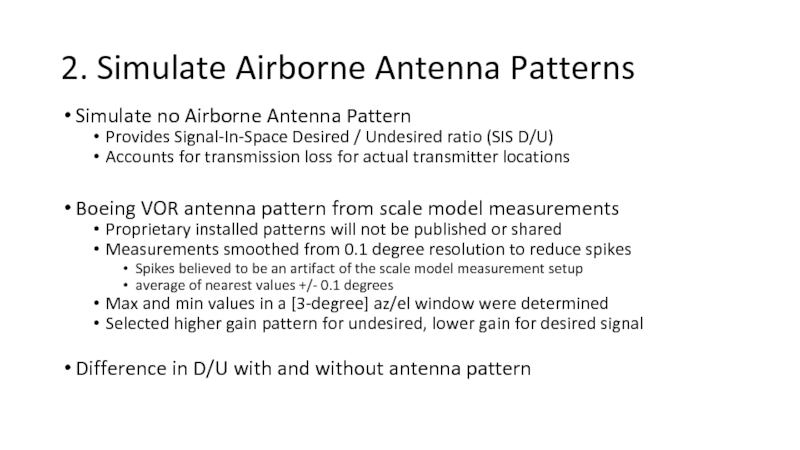
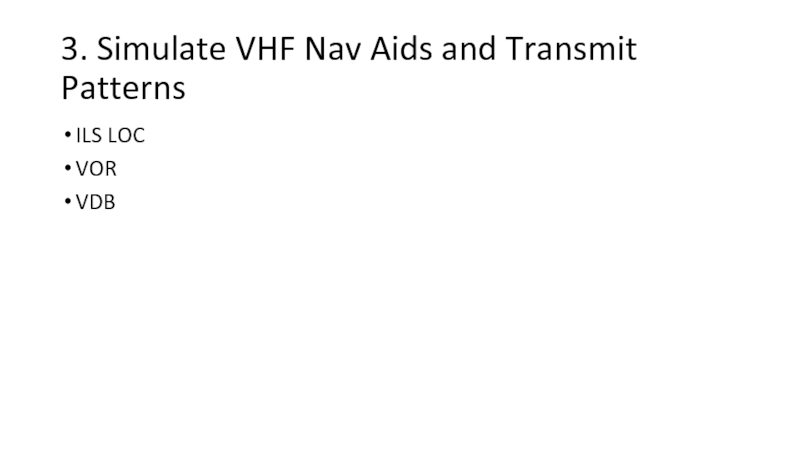
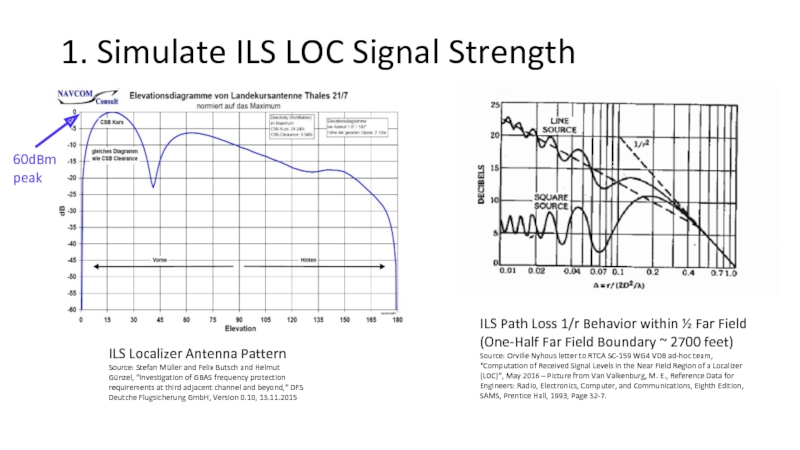
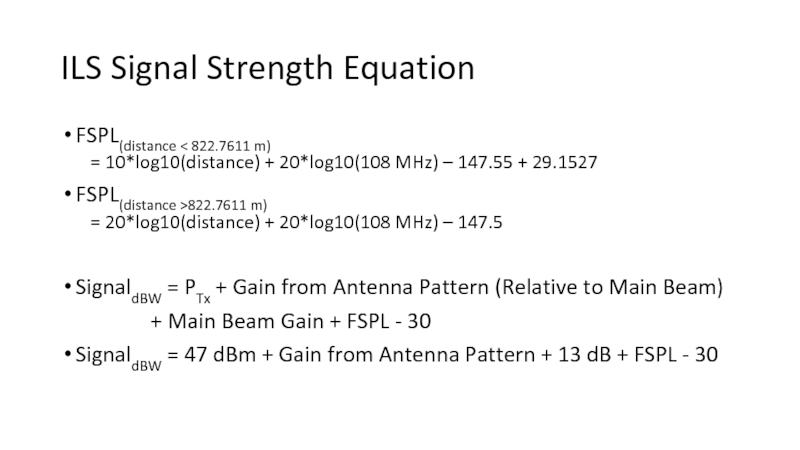
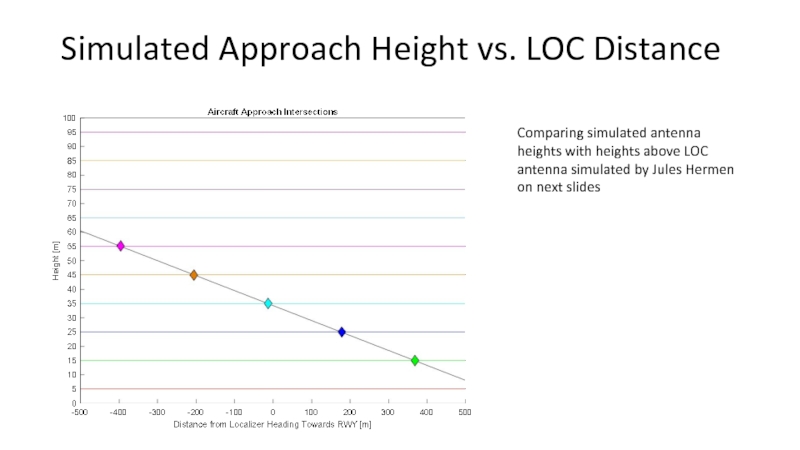
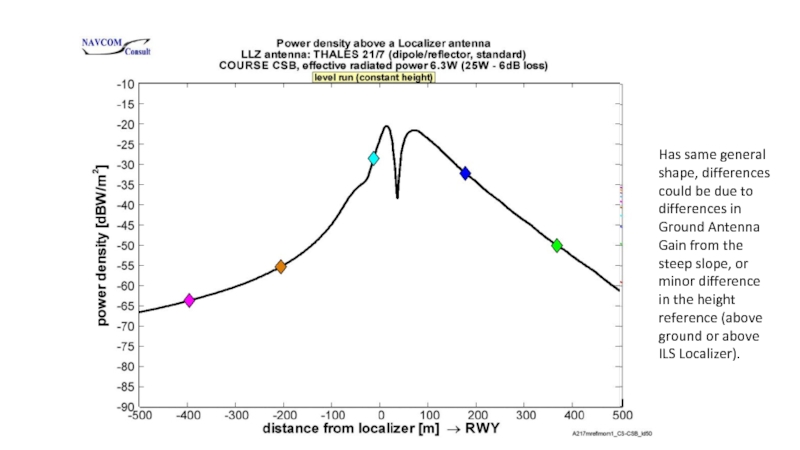
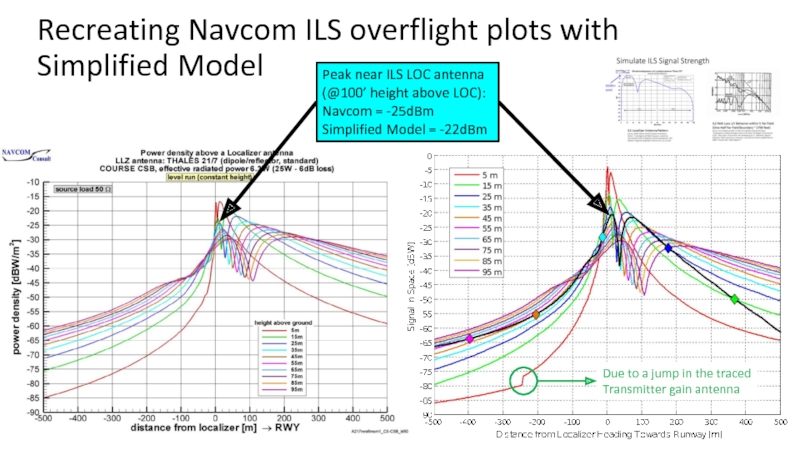
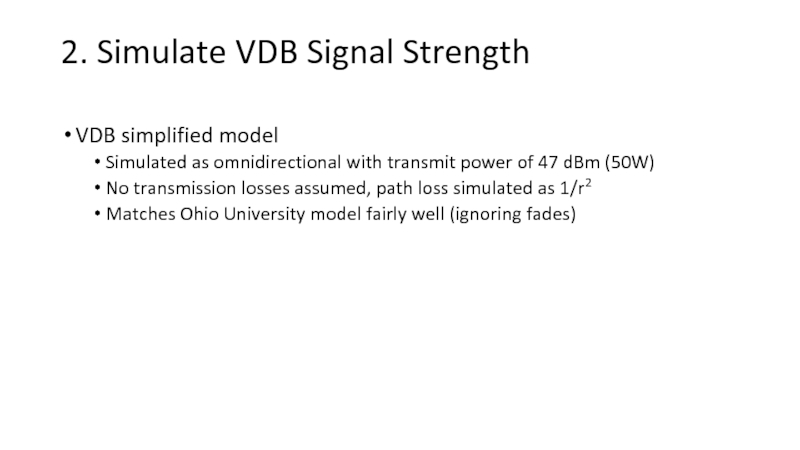
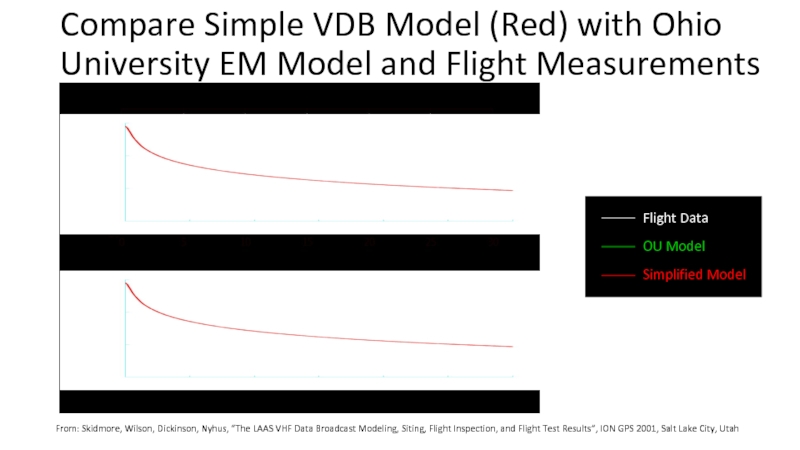
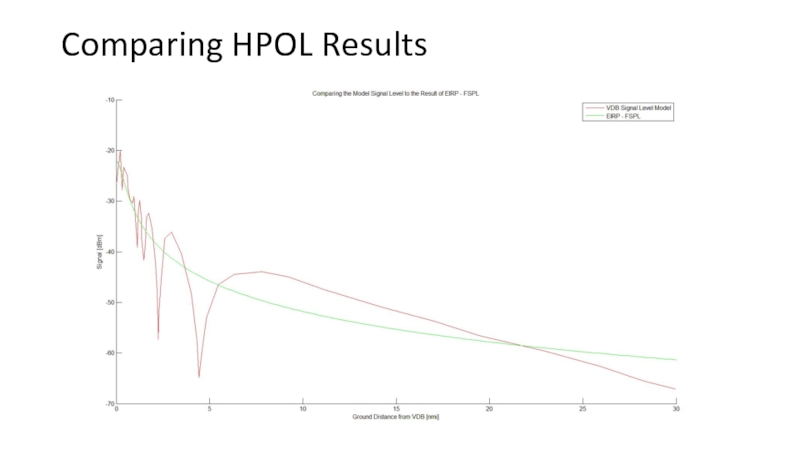
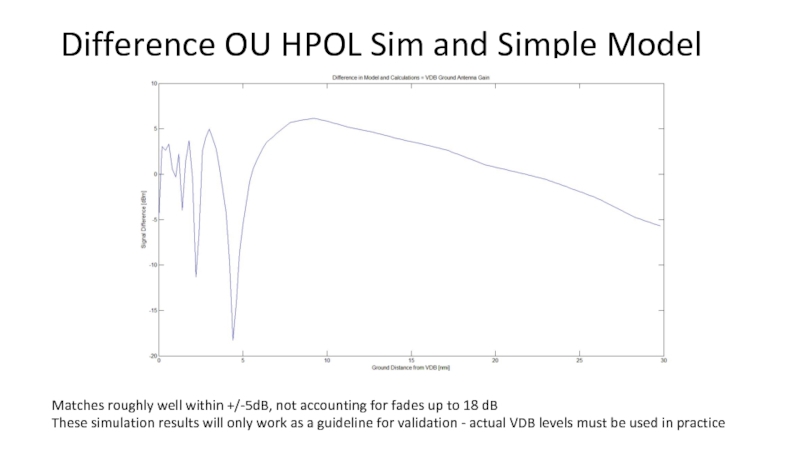
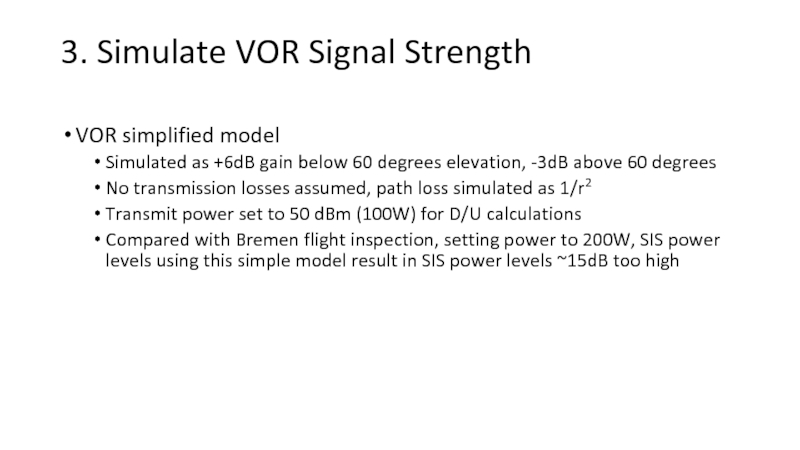
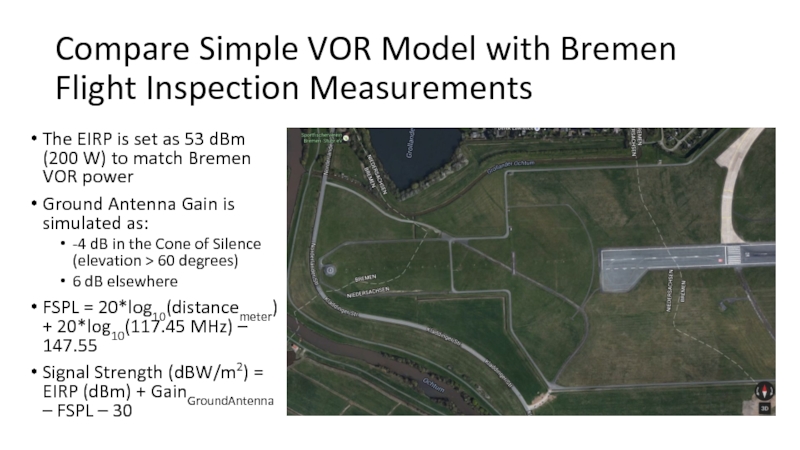
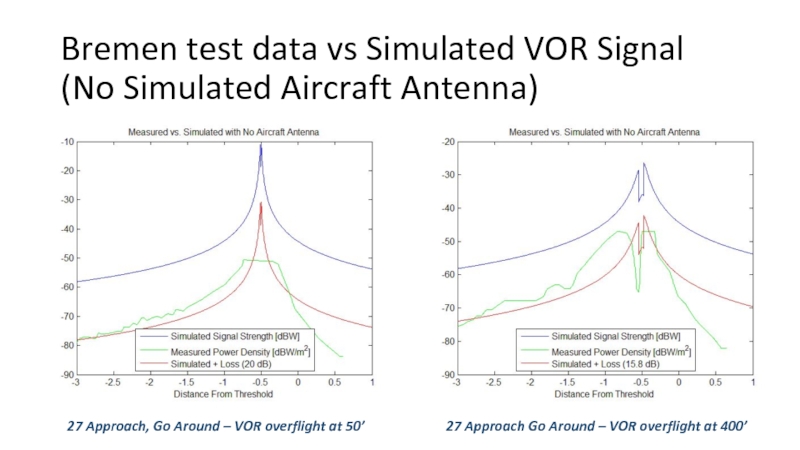
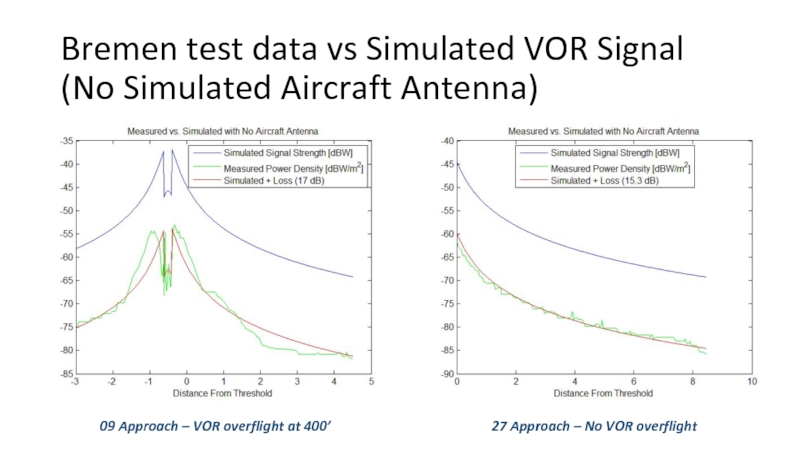
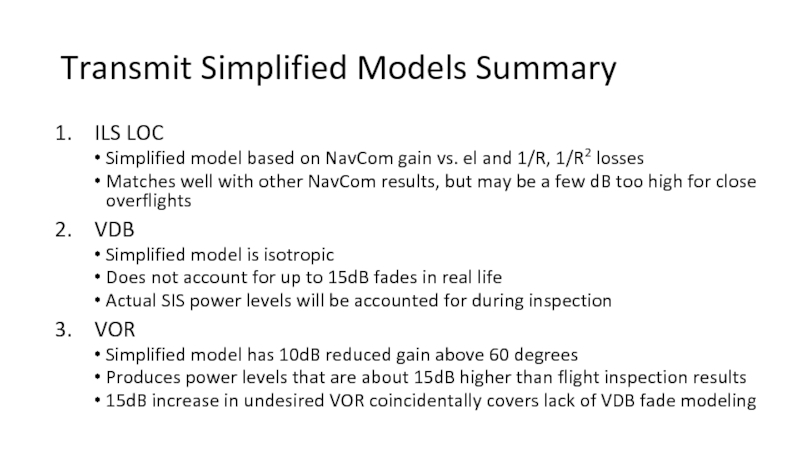
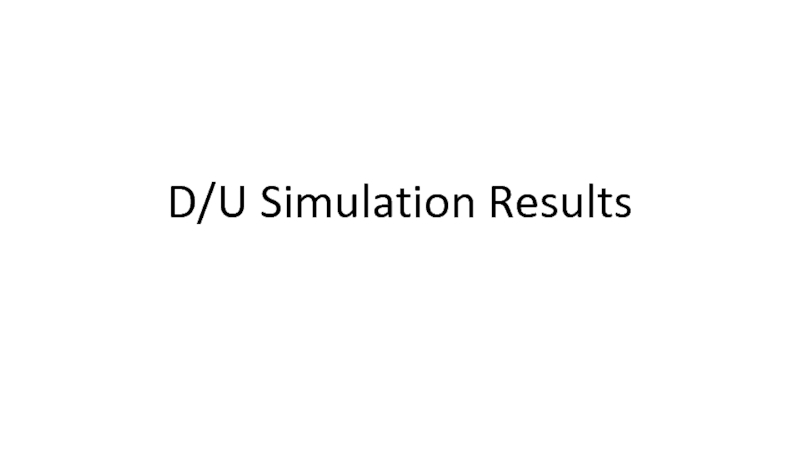
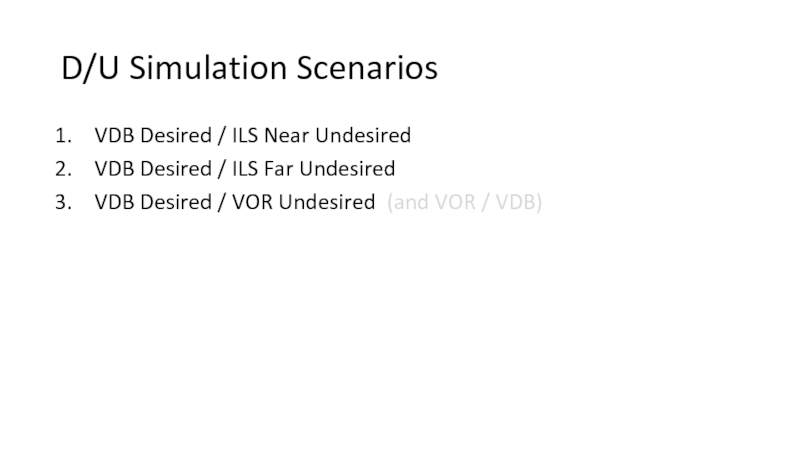
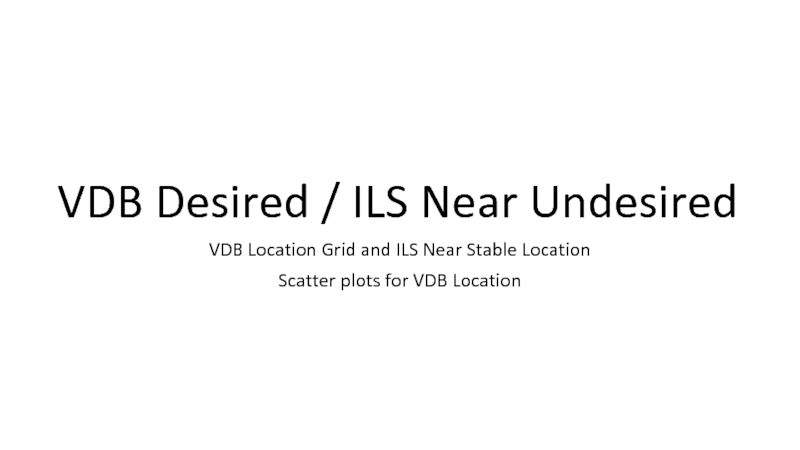
![FormulasEIRPVDB = 47 dBm [1]EIRPILS in the main beam = 60 dBm [1] Gtransmitter,VDB =](/img/tmb/5/476827/a757bb1626bb3fcba1a61267d627bf28-800x.jpg)
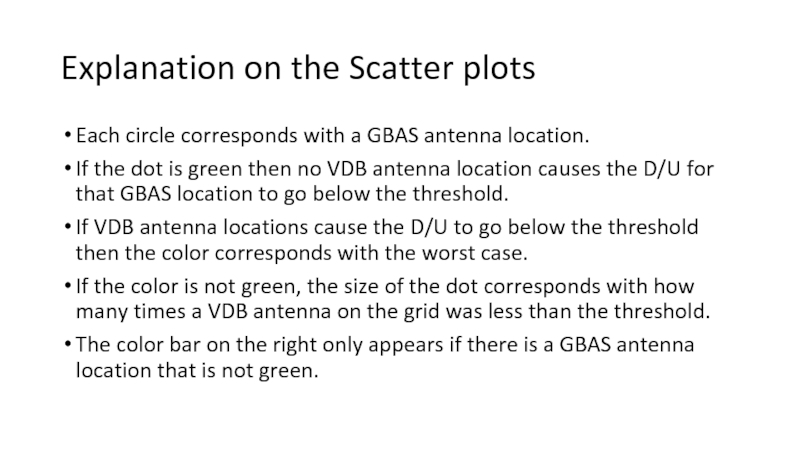
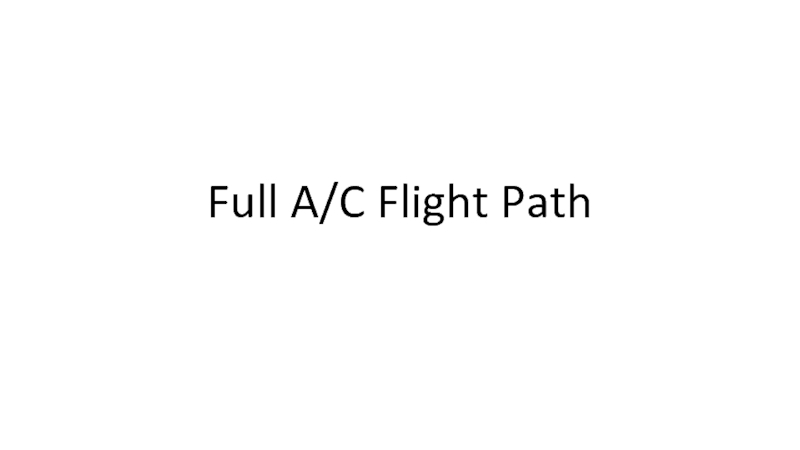
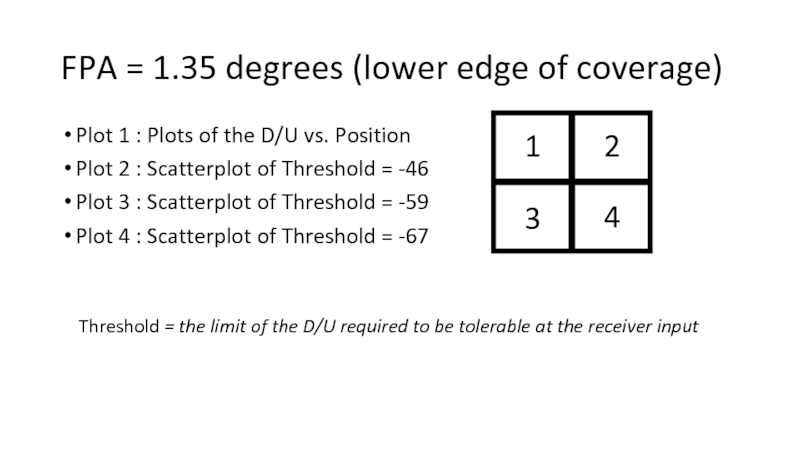
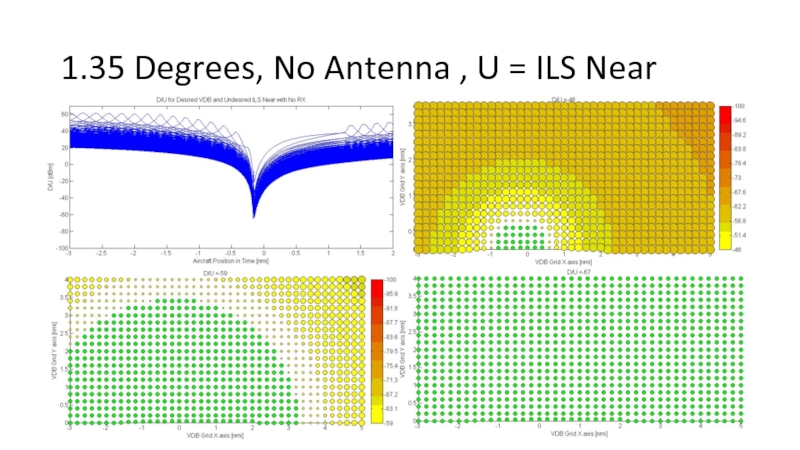
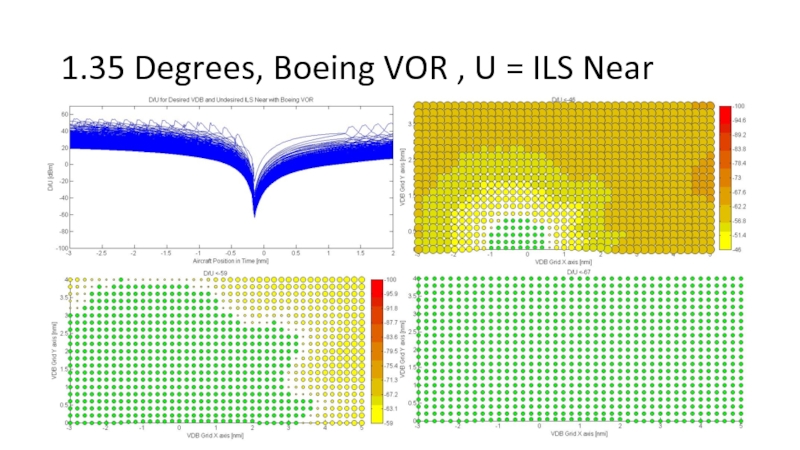
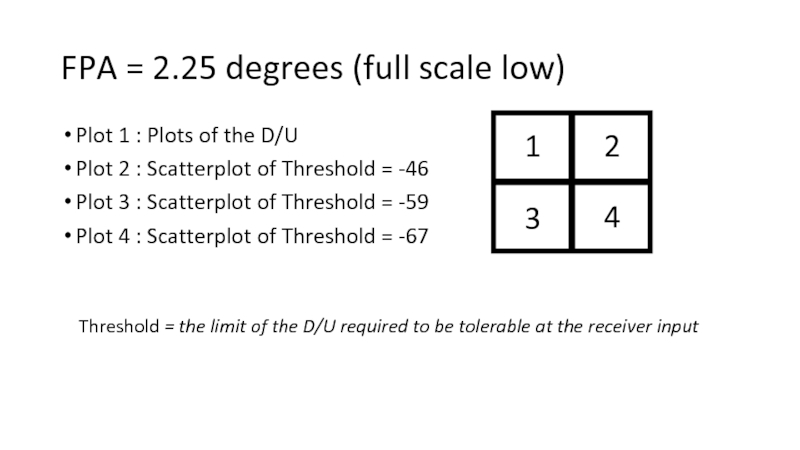
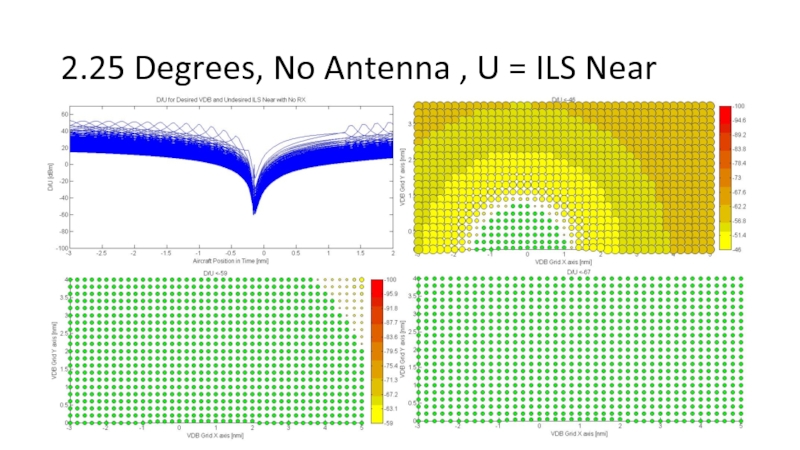
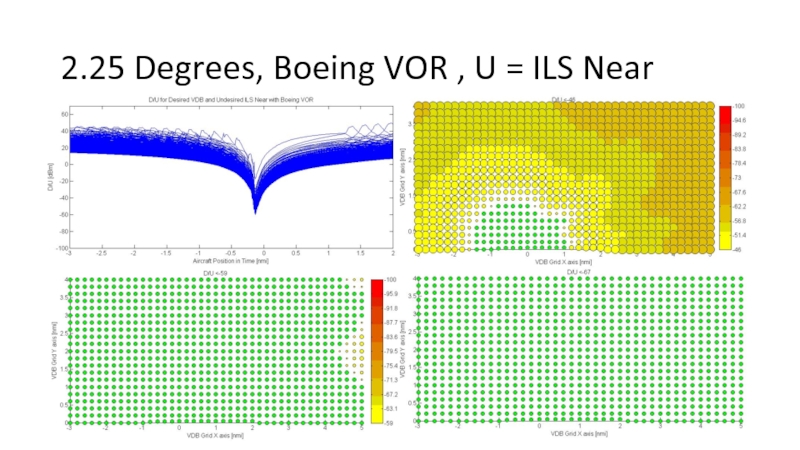
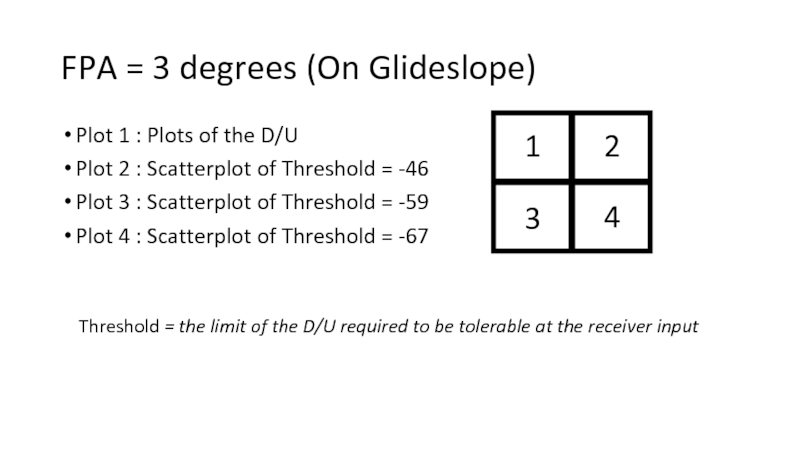
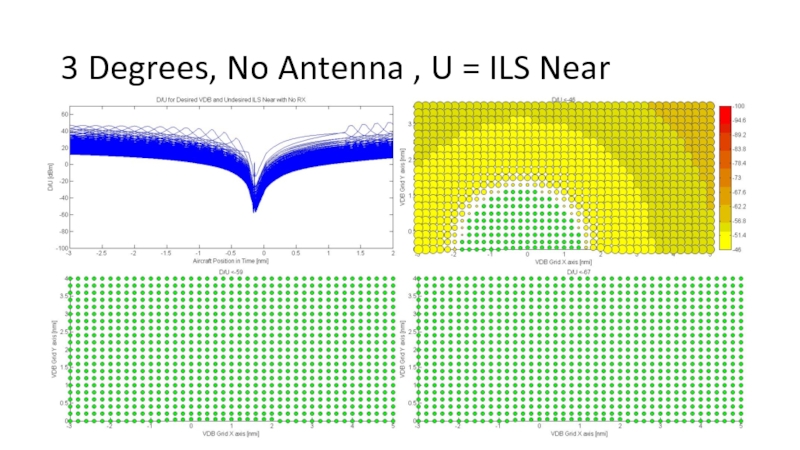
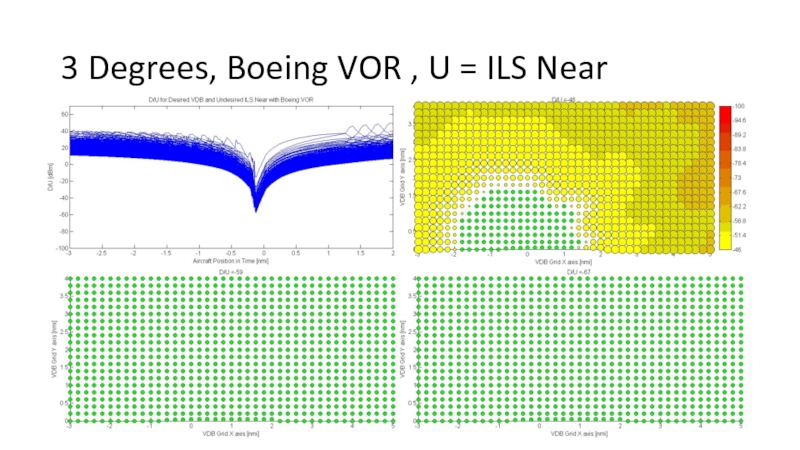
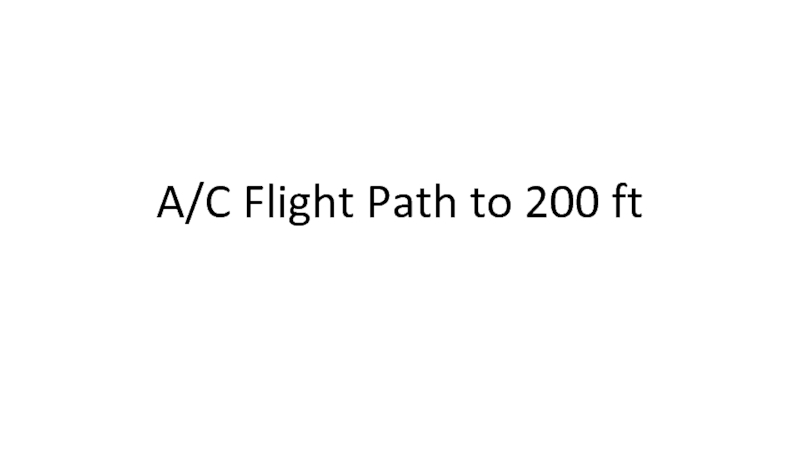
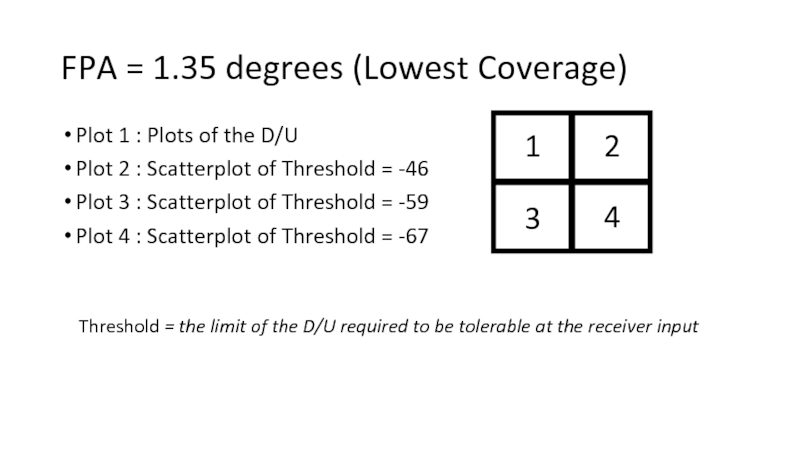
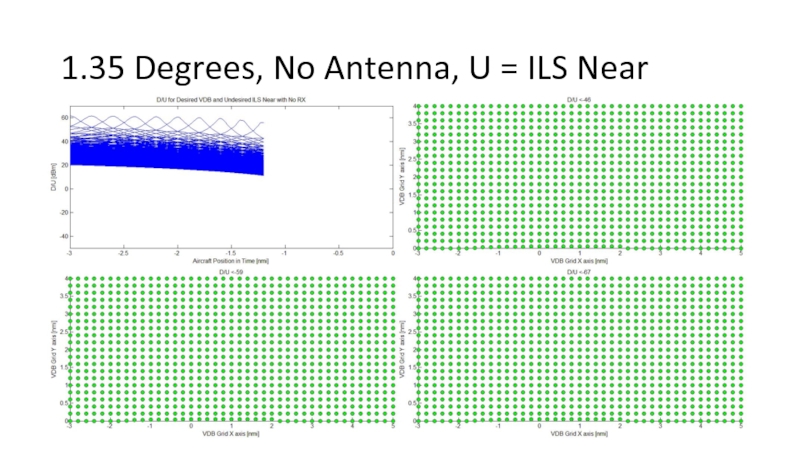
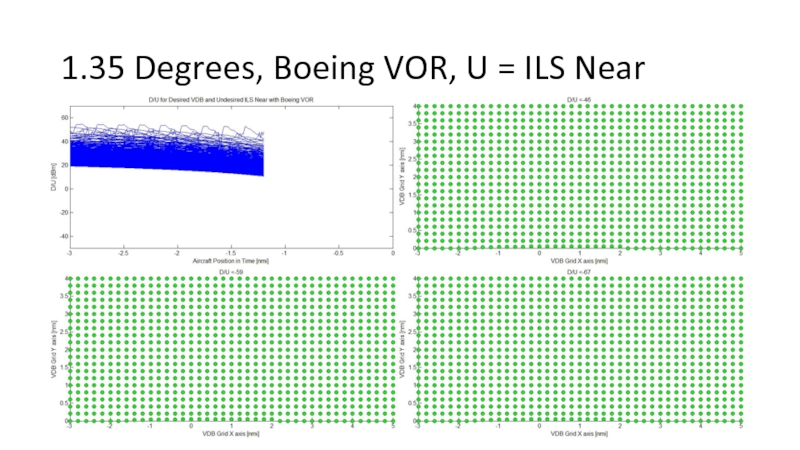
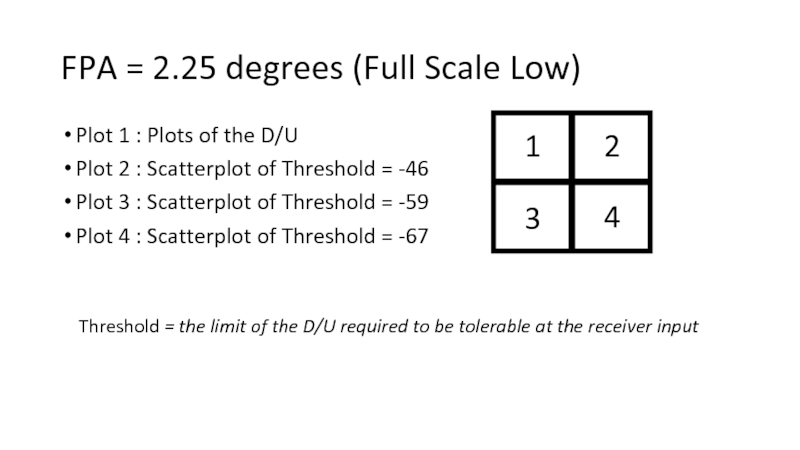
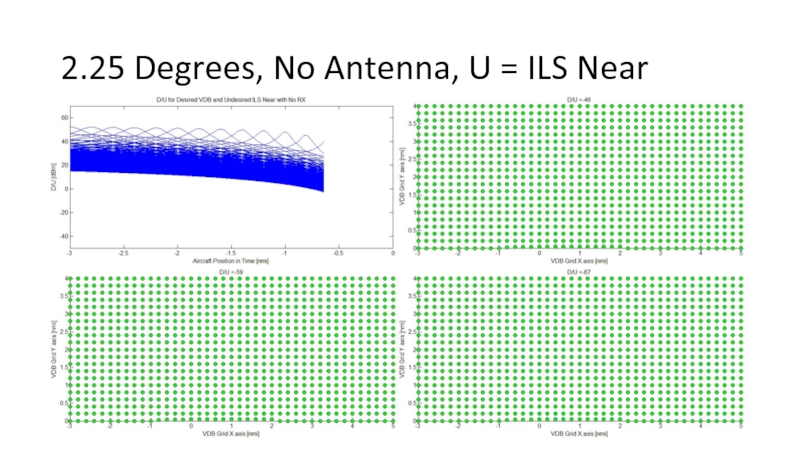
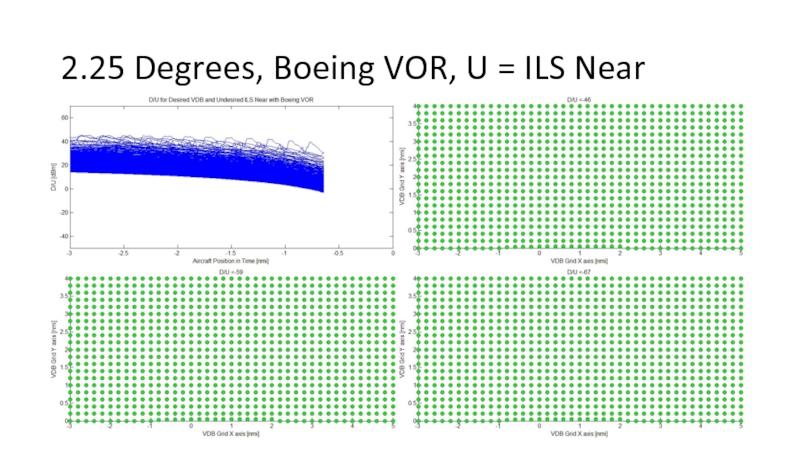
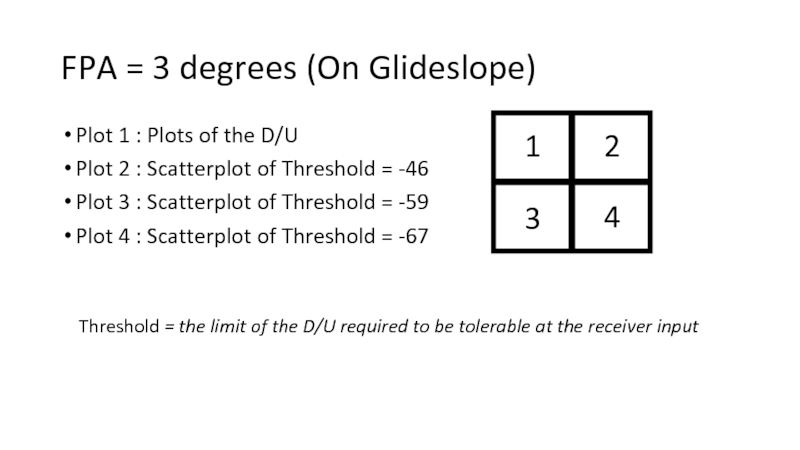
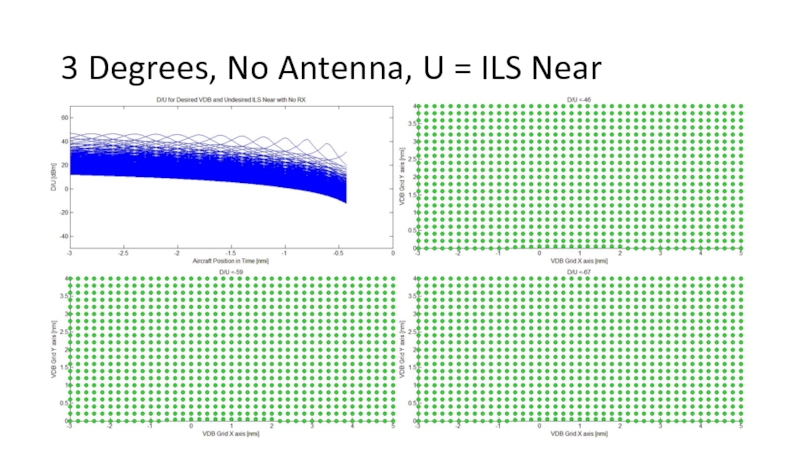
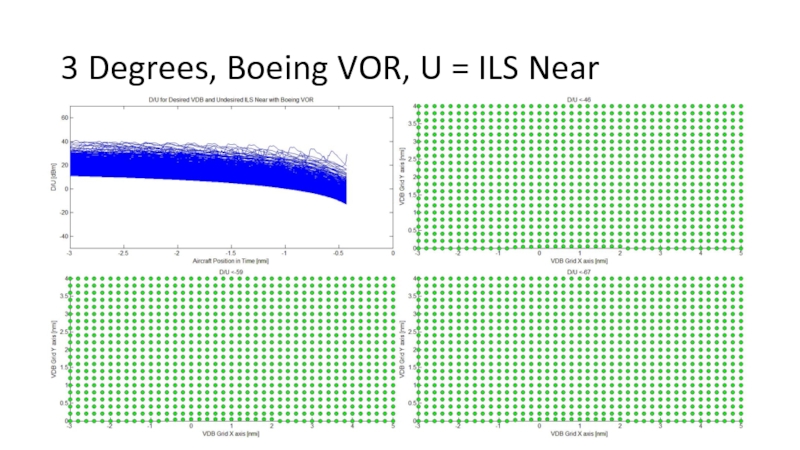
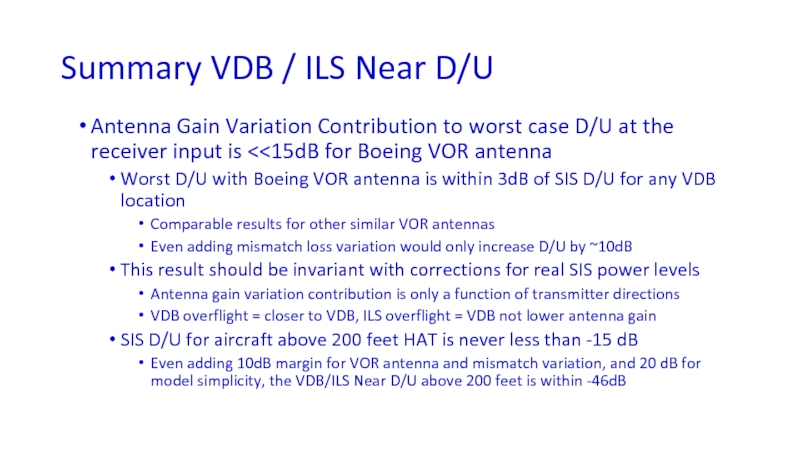
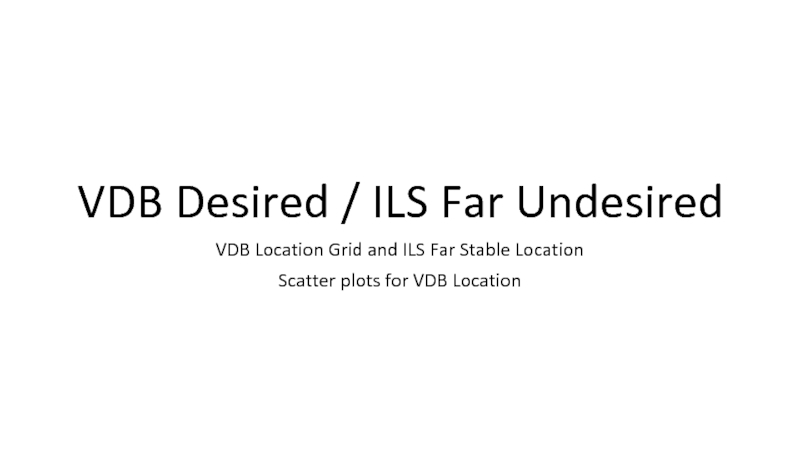
![FormulasEIRPVDB = 47 dBm [1]EIRPILS in the main beam = 60 dBm [1]GTransmitter,VDB = 0](/img/tmb/5/476827/cfd9910664867cde7b8bff8c04b720e3-800x.jpg)
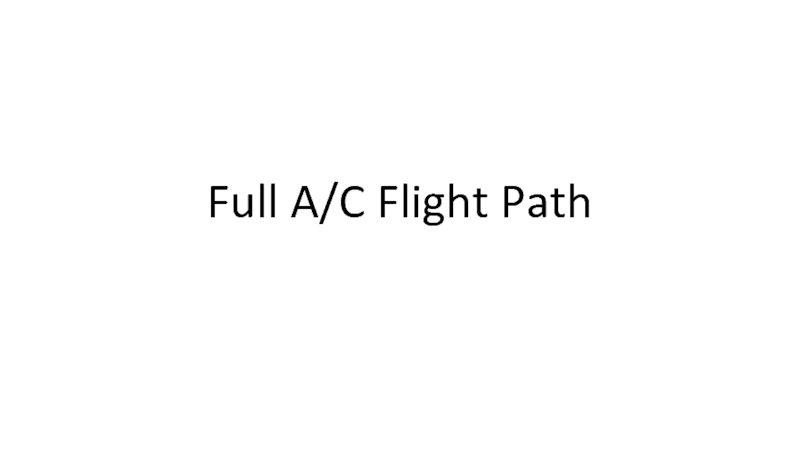
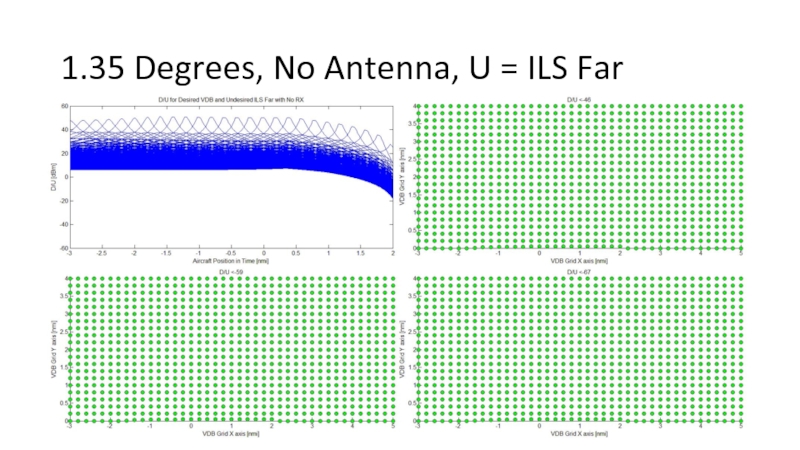
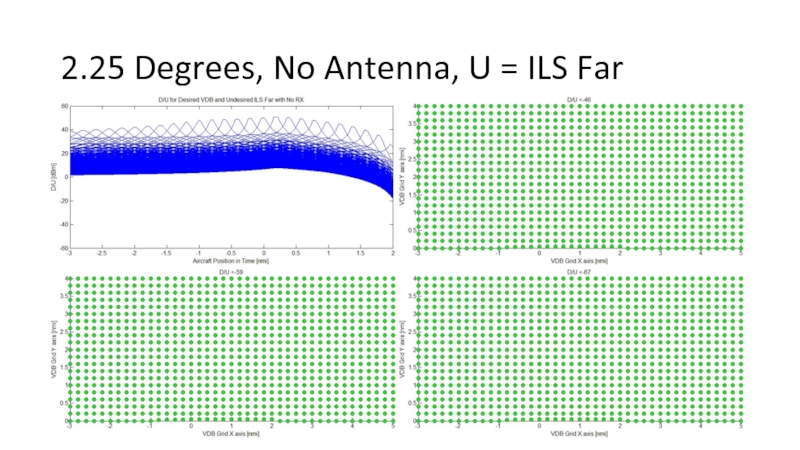
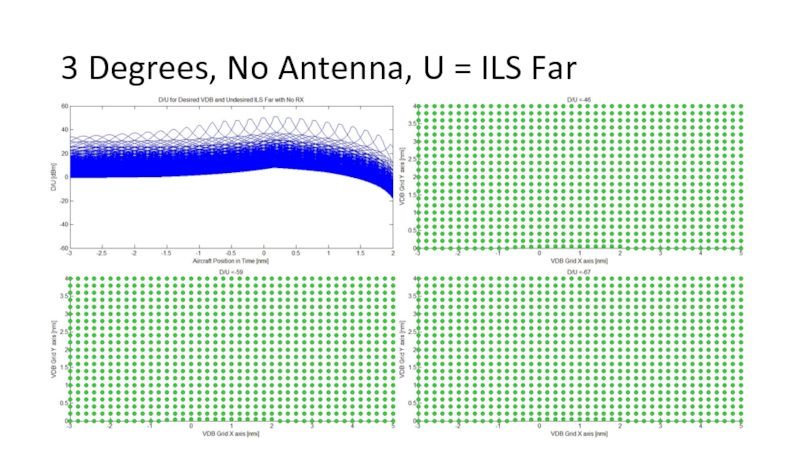
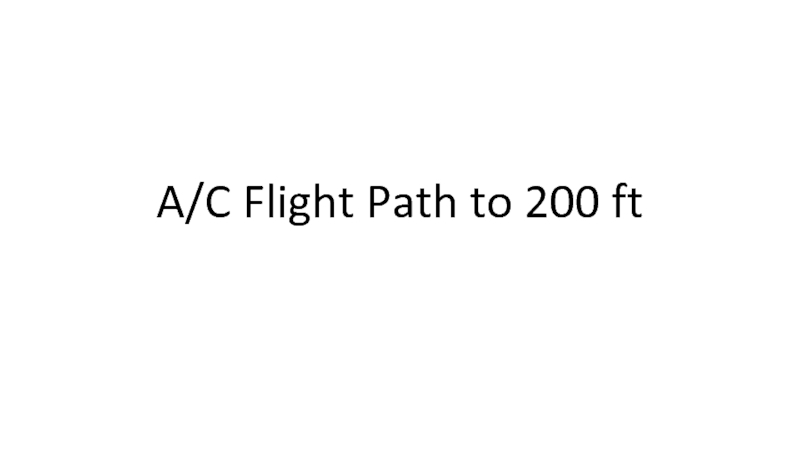
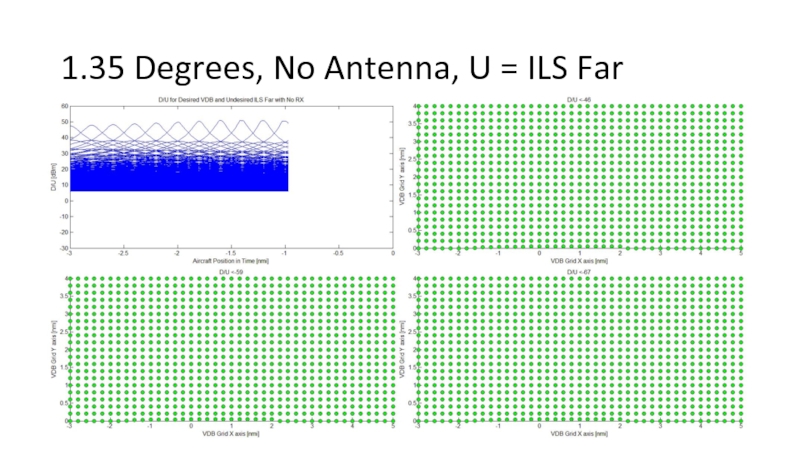
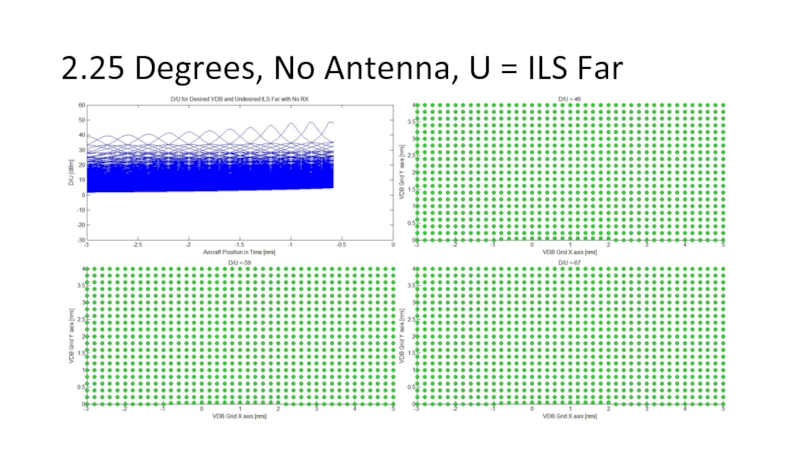
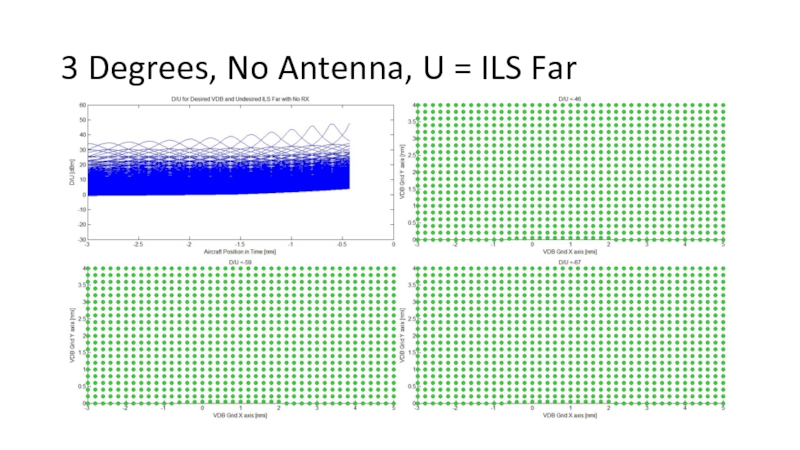
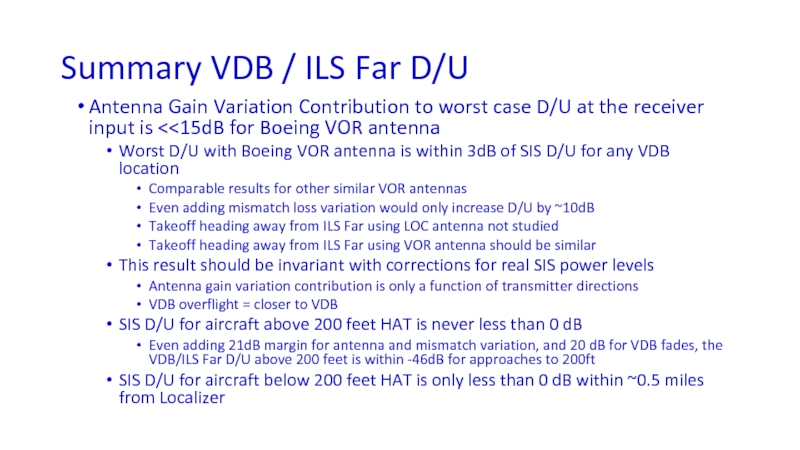
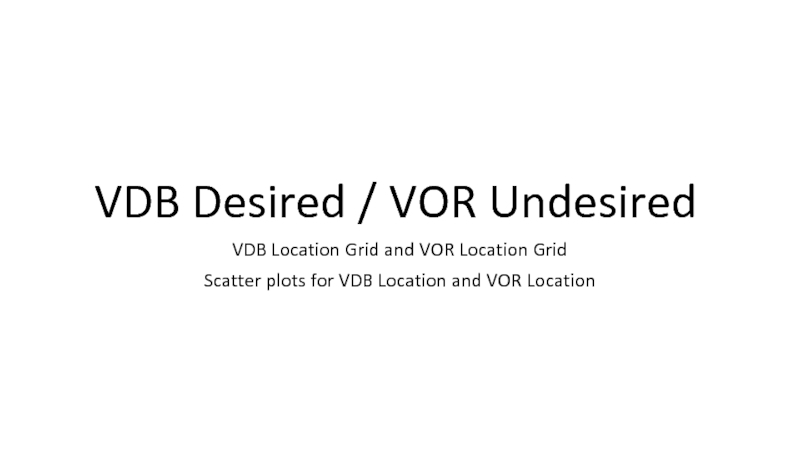
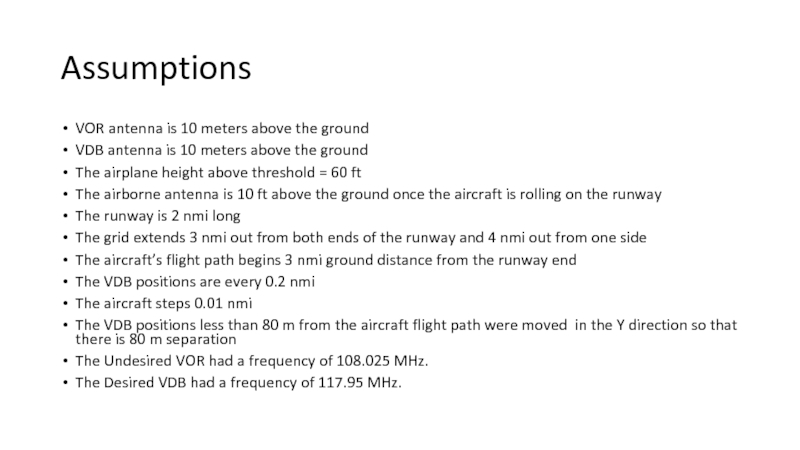
![FormulasEIRPVDB = 47 dBm [1]EIRPVOR = 50 dBm [1]GTransmitter,VDB = 0 dB (Isotropic Antenna)GTransmitter,VOR =](/img/tmb/5/476827/c9fa85d40f1533f257923a279afe3af7-800x.jpg)
